Click on the pictures to get a better view and to scroll through easier. We also have more pictures on Facebook.
At the center, there are different activities to do throughout the day to practice good deeds. Each night we met at 7 to decide which activities we wanted to participate in the following day. There is rice washing, patient care, patient washing, make them move (being creative with movement), physiotherapy, teaching kids/adults English, learning Burmese from a resident, cooking dinner for all volunteers, pagoda party (taking patients outside to the pagoda to pray), and ALMS (collecting donations). The center provides gloves, face masks, disinfectant solutions, etc. to protect the volunteers and the patients. Also, a volunteer coordinator is always present to show the right procedure and to answer any questions you might have.
 The first day of volunteering, Jesse and I both signed up for ALMS. Where we go into town in the early morning with the monks and nuns and collect donations from the community. It’s pretty unreal to be sitting in a bus full of Burmese Monks. We had just watched this happen down our street in front of our guesthouse and now we’re being a part of it, hands on. As I rode on the bus full of monks, I had this image in my mind as if I was a reporter on the BBC channel about to do some wild story. Never would I have imagined being in Burma, let alone doing this, but that’s the fun part about not planning a trip too much. If you just go with the flow and take chances, you never know where you’ll land. An hour later I stepped off the bus into a town I didn’t even know the name of. I was given a large empty rice bag that would soon be used to collect an assortment of donations. Coffee, rice, fruit, cookies, vegetables, drinks, cooking oil, soy milk, and anything else locals wished to share, everything was accepted. Another volunteer was given a collection bowl to carry for the money donations. Jesse and I were separated into different buses, I thought we would end up meeting at the same place but he never came. It turned out that each bus went to a different town.
The first day of volunteering, Jesse and I both signed up for ALMS. Where we go into town in the early morning with the monks and nuns and collect donations from the community. It’s pretty unreal to be sitting in a bus full of Burmese Monks. We had just watched this happen down our street in front of our guesthouse and now we’re being a part of it, hands on. As I rode on the bus full of monks, I had this image in my mind as if I was a reporter on the BBC channel about to do some wild story. Never would I have imagined being in Burma, let alone doing this, but that’s the fun part about not planning a trip too much. If you just go with the flow and take chances, you never know where you’ll land. An hour later I stepped off the bus into a town I didn’t even know the name of. I was given a large empty rice bag that would soon be used to collect an assortment of donations. Coffee, rice, fruit, cookies, vegetables, drinks, cooking oil, soy milk, and anything else locals wished to share, everything was accepted. Another volunteer was given a collection bowl to carry for the money donations. Jesse and I were separated into different buses, I thought we would end up meeting at the same place but he never came. It turned out that each bus went to a different town.
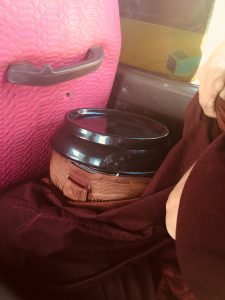 There was a small truck at the beginning just before us with a loudspeaker announcing to the community that we were walking through. We walked around town for about an hour and a half, barefoot. I found it very peaceful. I also learned that my feet are generally pretty soft on the bottoms, so if I stepped on a rock at the right angle, it didn’t feel too well. Jesse and I both witnessed many locals who clearly didn’t have a lot of money yet they donated what they could, usually, a bowl of uncooked white rice often topped off with a questionable amount of money. There were two ladies that came out of their houses with stacks of money giving some to each of the 15 monks. Some locals also donated cooked rice and other dishes. A spoonful of the rice was given to the head monk in the bowl that was carried around his neck. The rest would be placed in a bin which would later be eaten for lunch, same goes for the vegetables. As locals walked up to us first they took their shoes off and walked toward the head monk with their item in hand for a blessing. After having the item blessed by the monks, the donation would be placed into either the money bowl, empty rice bags or bins for cooked food. There were times when children would be the ones to hand over the donations, it was really sweet to witness.
There was a small truck at the beginning just before us with a loudspeaker announcing to the community that we were walking through. We walked around town for about an hour and a half, barefoot. I found it very peaceful. I also learned that my feet are generally pretty soft on the bottoms, so if I stepped on a rock at the right angle, it didn’t feel too well. Jesse and I both witnessed many locals who clearly didn’t have a lot of money yet they donated what they could, usually, a bowl of uncooked white rice often topped off with a questionable amount of money. There were two ladies that came out of their houses with stacks of money giving some to each of the 15 monks. Some locals also donated cooked rice and other dishes. A spoonful of the rice was given to the head monk in the bowl that was carried around his neck. The rest would be placed in a bin which would later be eaten for lunch, same goes for the vegetables. As locals walked up to us first they took their shoes off and walked toward the head monk with their item in hand for a blessing. After having the item blessed by the monks, the donation would be placed into either the money bowl, empty rice bags or bins for cooked food. There were times when children would be the ones to hand over the donations, it was really sweet to witness.
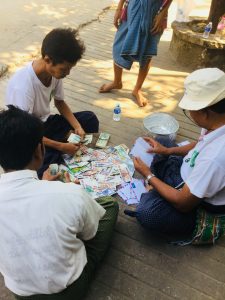 This was very humbling to see the donations collected in just a little over an hour and the beautiful thing is that this happens daily in different locations. At the end of each ALMS session, all of the money is dumped onto the sidewalk and counted before getting into the bus. Often water, fruit, and other snacks are donated and when you get on the bus the monks hand you some goodies for yourself. Then we headed back to the center with all of the donations. The uncooked rice gets set aside for washing the next morning and all of the cooked food is served for anyone who would like free lunch. These are the donations along with uncooked food that all 3,000+ people at the center eat. Since ALMS is something that continues to happen daily, there is a constant flow of food coming into the center. We ate lunch the first day then decided to order from the local tea shop for the rest of our time at Thabarwa. In Asia often meat is hidden in dishes or fish sauce is used so when you have cooked food from many different people it’s best for Vegans to eat elsewhere. From what I’ve experienced through ALMS, Burmese culture is very rich in morals, traditional beliefs and their understanding of karma. Their actions are reflected based on their belief that what you do now will have either a positive or negative effect on both your present, future and your next life.
This was very humbling to see the donations collected in just a little over an hour and the beautiful thing is that this happens daily in different locations. At the end of each ALMS session, all of the money is dumped onto the sidewalk and counted before getting into the bus. Often water, fruit, and other snacks are donated and when you get on the bus the monks hand you some goodies for yourself. Then we headed back to the center with all of the donations. The uncooked rice gets set aside for washing the next morning and all of the cooked food is served for anyone who would like free lunch. These are the donations along with uncooked food that all 3,000+ people at the center eat. Since ALMS is something that continues to happen daily, there is a constant flow of food coming into the center. We ate lunch the first day then decided to order from the local tea shop for the rest of our time at Thabarwa. In Asia often meat is hidden in dishes or fish sauce is used so when you have cooked food from many different people it’s best for Vegans to eat elsewhere. From what I’ve experienced through ALMS, Burmese culture is very rich in morals, traditional beliefs and their understanding of karma. Their actions are reflected based on their belief that what you do now will have either a positive or negative effect on both your present, future and your next life.
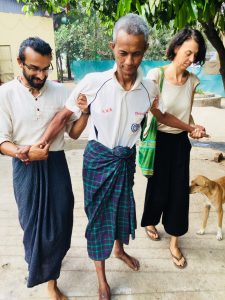 Physiotherapy is another activity I chose to do, it’s mainly helping the patients stretch, do movement exercises and walking. Some have lost the ability to walk on their own because of an accident or a stroke and they need you to slowly help guide them along by holding their hands and under their arms. The patients are very sweet and show so much gratitude for helping them. Somedays they can be very stubborn if they don’t want to do something you will know because they will throw a minor fit about it. There is a language barrier but you can use your hands more to communicate to see how they are feeling, thumbs up is good, when they hold their hand out sideways and move it back and forth in a rocking motion that means they aren’t doing so well. After doing some stretching we took two patients to the tea shop to relax and get them out of their beds. Many of the patients sit or lay in their beds all day and have nothing to do so even something as simple as walking them 20 feet to the tea shop to sit, drink tea and people watch is a special time for them. There are wheelchairs all around to borrow to push some patients throughout the center. Volunteers are encouraged to do this daily. There are some small hills so it’s often hard for patients in wheelchairs to go up them on their own. I really enjoyed this activity and realize how fulfilling it is to see the smiles on their faces when they push themselves to do the exercises and practice taking steps again.
Physiotherapy is another activity I chose to do, it’s mainly helping the patients stretch, do movement exercises and walking. Some have lost the ability to walk on their own because of an accident or a stroke and they need you to slowly help guide them along by holding their hands and under their arms. The patients are very sweet and show so much gratitude for helping them. Somedays they can be very stubborn if they don’t want to do something you will know because they will throw a minor fit about it. There is a language barrier but you can use your hands more to communicate to see how they are feeling, thumbs up is good, when they hold their hand out sideways and move it back and forth in a rocking motion that means they aren’t doing so well. After doing some stretching we took two patients to the tea shop to relax and get them out of their beds. Many of the patients sit or lay in their beds all day and have nothing to do so even something as simple as walking them 20 feet to the tea shop to sit, drink tea and people watch is a special time for them. There are wheelchairs all around to borrow to push some patients throughout the center. Volunteers are encouraged to do this daily. There are some small hills so it’s often hard for patients in wheelchairs to go up them on their own. I really enjoyed this activity and realize how fulfilling it is to see the smiles on their faces when they push themselves to do the exercises and practice taking steps again.
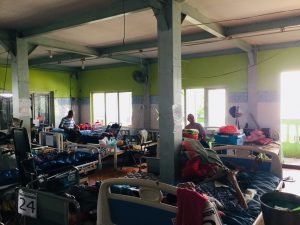 Patient care is definitely the hardest activity to choose but the one that will stick with you the most. I’m going to go into details so that you can fully understand. There were 4 main patients to take care of. One man was paralyzed from the waist down with minimal use of his arms. Over time he’s developed bed sores so along with physiotherapy he also needs special care with changing the bandages, his diaper, and bathing. He is the sweetest man, his eyes are very deep and even though his suffering and pain he has a smile on his face and is very grateful for the help. The main problem with the bed sores is that he doesn’t have a long-term person there to push him to his side for a few hours and then roll him back to relieve some of the pressure on his sores. If you roll him to his side he doesn’t stay for long because his hip begins to hurt or he loses stability, so a constant check on him is necessary. There are nurses that apparently are very busy but every time I see them they seem to be on their phones. It’s sad that something so simple isn’t being done, his sores are taking much longer to heal because he isn’t being rolled to his side enough. The second patient is also paralyzed with mostly healed bed sores so the process is similar. The third was born with a genetic skin disease where his legs are permanently stiff and cannot be bent open, his arms are stiff but have a little more flexibility than his legs but it is often very difficult to change his diaper and get him dressed. He has bed sores and is full of lumps and bumps all over every inch of his entire body which is creating permanent pain. I think he’s in his 60s but the appearance of his skin could just make him look much older, I couldn’t imagine living 60 years in his condition. No matter what amount of pain he was in he still had a smile on his face. I don’t think I’ve ever been in the presence of such a strong-willed person before. The fourth patient is a woman that had breast cancer. Both breasts were removed but there was an issue with surgery and her entire chest is burnt. I won’t go into details but it’s pretty severe and she isn’t receiving the proper care she needs. Since she’s living at the meditation center and it’s a Buddhist culture, pain medicine isn’t being used and she is in excruciating pain daily. It’s a little strange because we are told that meditation is one of the main solutions for her healing. Seeing her suffering you can clearly tell that she needs an actual doctor and it’s so hard to witness because you can’t do anything about it. At the moment nothings infected because it’s cleaned daily, but just using a simple water solution and a clean bandage are not going to heal it. I’m not so sure if she will ever fully recover and if it does get infected I fear there is a chance that it could result in her death. Seeing this woman along with the others has shown me how strong Burmese people are. In America, we’re so quick to go to the doctors for aches, pains, colds and other minor health issues. I don’t think I know anyone that would be able to handle the pain these people experience in their daily lives. I know one thing, I definitely wouldn’t want to get hurt in Burma. From what I’m seeing with both volunteers and patients their healthcare is not the best, but then again Thabarwa isn’t a legit hospital either.
Patient care is definitely the hardest activity to choose but the one that will stick with you the most. I’m going to go into details so that you can fully understand. There were 4 main patients to take care of. One man was paralyzed from the waist down with minimal use of his arms. Over time he’s developed bed sores so along with physiotherapy he also needs special care with changing the bandages, his diaper, and bathing. He is the sweetest man, his eyes are very deep and even though his suffering and pain he has a smile on his face and is very grateful for the help. The main problem with the bed sores is that he doesn’t have a long-term person there to push him to his side for a few hours and then roll him back to relieve some of the pressure on his sores. If you roll him to his side he doesn’t stay for long because his hip begins to hurt or he loses stability, so a constant check on him is necessary. There are nurses that apparently are very busy but every time I see them they seem to be on their phones. It’s sad that something so simple isn’t being done, his sores are taking much longer to heal because he isn’t being rolled to his side enough. The second patient is also paralyzed with mostly healed bed sores so the process is similar. The third was born with a genetic skin disease where his legs are permanently stiff and cannot be bent open, his arms are stiff but have a little more flexibility than his legs but it is often very difficult to change his diaper and get him dressed. He has bed sores and is full of lumps and bumps all over every inch of his entire body which is creating permanent pain. I think he’s in his 60s but the appearance of his skin could just make him look much older, I couldn’t imagine living 60 years in his condition. No matter what amount of pain he was in he still had a smile on his face. I don’t think I’ve ever been in the presence of such a strong-willed person before. The fourth patient is a woman that had breast cancer. Both breasts were removed but there was an issue with surgery and her entire chest is burnt. I won’t go into details but it’s pretty severe and she isn’t receiving the proper care she needs. Since she’s living at the meditation center and it’s a Buddhist culture, pain medicine isn’t being used and she is in excruciating pain daily. It’s a little strange because we are told that meditation is one of the main solutions for her healing. Seeing her suffering you can clearly tell that she needs an actual doctor and it’s so hard to witness because you can’t do anything about it. At the moment nothings infected because it’s cleaned daily, but just using a simple water solution and a clean bandage are not going to heal it. I’m not so sure if she will ever fully recover and if it does get infected I fear there is a chance that it could result in her death. Seeing this woman along with the others has shown me how strong Burmese people are. In America, we’re so quick to go to the doctors for aches, pains, colds and other minor health issues. I don’t think I know anyone that would be able to handle the pain these people experience in their daily lives. I know one thing, I definitely wouldn’t want to get hurt in Burma. From what I’m seeing with both volunteers and patients their healthcare is not the best, but then again Thabarwa isn’t a legit hospital either.
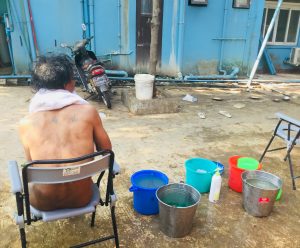 Patient washing was my favorite activity. There are quite a few different buildings with groups of patients, some buildings are all men, some all women and some are a mixture filled with those that were once homeless. Each day we went to a different building, bringing wheelchairs, buckets, bowls, soap, cloths, and towels and we washed anyone that needed or wanted washing. I’ve never washed a grown adult before but it didn’t really seem weird to me either. My thoughts immediately were, someday this could be me, Jesse or someone in my family and I would want them to be clean and taken care of. Once you reach a certain age and your body begins breaking down or you develop a sickness, you become similar to a baby again. Helpless and in need of care in order to be happy and feel loved. The hard part is dressing them if you’ve ever struggled to get clothes on a child or baby, try a grown adult that can’t assist you. It’s a challenge, especially if they lost function in their arms or legs and they have stiffness in their muscles. It’s like trying to bend a wooden board into the sleeve of a t-shirt, there is a method though. There were many volunteers that wouldn’t try this activity, but to me it was very fulfilling getting patients who clearly needed a bath, washing them, clothing them, then wheeling them back to their bed with smiles on their faces. After bathing over 25-30 patients you are partially wet, sweaty and need a shower yourself. The shower after feels pretty satisfying, as you wash your own body you feel energized and cleansed. There are 100s of patients and without this, as an activity, many would go without being bathed for days, weeks, maybe even months. It really is needed and I have developed so much gratitude toward all of the nurses and people that work in human services or with people that have disabilities. I realize I would have been great going into a patient care type of field. I did this activity the most because it was needed the most in my opinion and I had fun. The group of women in the all-women building are really fun to spend time with and you always walk away feeling happier.
Patient washing was my favorite activity. There are quite a few different buildings with groups of patients, some buildings are all men, some all women and some are a mixture filled with those that were once homeless. Each day we went to a different building, bringing wheelchairs, buckets, bowls, soap, cloths, and towels and we washed anyone that needed or wanted washing. I’ve never washed a grown adult before but it didn’t really seem weird to me either. My thoughts immediately were, someday this could be me, Jesse or someone in my family and I would want them to be clean and taken care of. Once you reach a certain age and your body begins breaking down or you develop a sickness, you become similar to a baby again. Helpless and in need of care in order to be happy and feel loved. The hard part is dressing them if you’ve ever struggled to get clothes on a child or baby, try a grown adult that can’t assist you. It’s a challenge, especially if they lost function in their arms or legs and they have stiffness in their muscles. It’s like trying to bend a wooden board into the sleeve of a t-shirt, there is a method though. There were many volunteers that wouldn’t try this activity, but to me it was very fulfilling getting patients who clearly needed a bath, washing them, clothing them, then wheeling them back to their bed with smiles on their faces. After bathing over 25-30 patients you are partially wet, sweaty and need a shower yourself. The shower after feels pretty satisfying, as you wash your own body you feel energized and cleansed. There are 100s of patients and without this, as an activity, many would go without being bathed for days, weeks, maybe even months. It really is needed and I have developed so much gratitude toward all of the nurses and people that work in human services or with people that have disabilities. I realize I would have been great going into a patient care type of field. I did this activity the most because it was needed the most in my opinion and I had fun. The group of women in the all-women building are really fun to spend time with and you always walk away feeling happier.
Jesse and I taught English to the children 1 day. They are very cute and eager to learn. Although teaching is my field I saw how important some of the other activities were that I decided to let the other volunteers do the teaching. Jesse mainly did work on fixing a few doors, getting the golf cart running again and fixing wheelchairs. I pushed him to step out of his comfort zone and he helped with patient washing 3 days in a row!
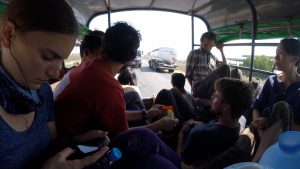 One of the days we were there we had the opportunity to travel 3 hours one way to go visit an animal shelter that the center owns. We were told there would be 100s of dogs, a few bears, elephants, and snakes, so I immediately wanted to do it. We waited out front our dorm for the bus, by bus I mean open-air truck with two long hard seats like bleachers, it usually seats about 20 or 25, including the floor. We originally had 15 people interested but once some of them saw the riding conditions they bailed. There were about 20 large water cooler jugs to put in the back with us, along with 3 or 4 large rice bags filled with food and two large size garbage bins, also with food. At the time none of us understood what all that water and food was for but we would soon find out.
One of the days we were there we had the opportunity to travel 3 hours one way to go visit an animal shelter that the center owns. We were told there would be 100s of dogs, a few bears, elephants, and snakes, so I immediately wanted to do it. We waited out front our dorm for the bus, by bus I mean open-air truck with two long hard seats like bleachers, it usually seats about 20 or 25, including the floor. We originally had 15 people interested but once some of them saw the riding conditions they bailed. There were about 20 large water cooler jugs to put in the back with us, along with 3 or 4 large rice bags filled with food and two large size garbage bins, also with food. At the time none of us understood what all that water and food was for but we would soon find out.
After everything was put in the truck there was enough room to fit maybe 5 people comfortably, we still left with 12 people. If only you could have seen Jesse’s face, he gave me the are you kidding me look. The trip reminded me of both a time in Haiti riding in the back of the truck through the mountains and the dust filled roads in Ghana with the occasional dust storm in your face. It might be strange to say but I love these type of rides. Although they are dirty, extremely bumpy and loud, there’s something special about listening to a good playlist and having the wind in your hair.
 So after a few random stops, we make it to the shelter and we pull up to a building where there are over 100 people ready to greet us. First, we parked and dropped off all of the water we brought then we got back in the truck and drove down the street to another building. One of the nuns did some talking and then we were off. We passed a bear and some dogs in cages and there was a monkey chained to the ledge of the building, but that was all of the animals we saw. Apparently, the bear was rescued from a bad situation but since this is not his natural habitat he can’t be let loose anywhere. It reminded me of when I was in South Korea and my school I was teaching at had a “zoo”, which turned out to be only a few deer trapped in a cage. When you hear animal shelter or zoo you get this general image in your mind of what you think it might be like, when in another country it seems best to just drop all previous images because you really never know what you’re stepping into.
So after a few random stops, we make it to the shelter and we pull up to a building where there are over 100 people ready to greet us. First, we parked and dropped off all of the water we brought then we got back in the truck and drove down the street to another building. One of the nuns did some talking and then we were off. We passed a bear and some dogs in cages and there was a monkey chained to the ledge of the building, but that was all of the animals we saw. Apparently, the bear was rescued from a bad situation but since this is not his natural habitat he can’t be let loose anywhere. It reminded me of when I was in South Korea and my school I was teaching at had a “zoo”, which turned out to be only a few deer trapped in a cage. When you hear animal shelter or zoo you get this general image in your mind of what you think it might be like, when in another country it seems best to just drop all previous images because you really never know what you’re stepping into.
We made our way back to the original location and the road was lined with people sitting on the ground. At first, we had no idea what we were doing there but then all of the bins and rice bags came out of the truck and items were slowly dispersed between all of the people of the village. There was an assortment of food, rice, sugar, potatoes, beans…the list is endless, even the children received something. There were lots of smiling faces and many people wanted their picture taken with their children. So, what we thought was a trip to an animal shelter turned out to be more of a missions trip to deliver donations, which was a wonderful experience but I was really looking forward to elephants, a bear and other animals like we were told. This was a great lesson about having expectations and having it turn out complete opposite of what you thought.
After making one more pit stop to cut up a watermelon to share, we were off on the 3-hour journey back to the center. Burmese people love watermelon, as you drive you can see hundreds of watermelons along the roadside. This experience was pretty interesting considering all 12 of us thought we were going to see some animals. It felt nice to hand out food even though I had nothing to do with the donations. It reminded me of being in Ghana and bringing all the school supplies, no matter what each person received it was all appreciated and they are eternally grateful.
Not one of these activities could happen without the help of the volunteers, especially the long-term volunteers that have been at Thabarwa for months/years. After a week I wondered how they could live here long term but then I fully experienced the work and good deeds they are doing and I understood. Without their determination and compassion, the patients would lose all of their individual care and would likely develop more sickness. It’s been a week since leaving Thabarwa and I think of the patients every day, I could see why volunteers go back again. The people you care for really leave an imprint on your soul and make you question what you are doing to lend a hand where it is needed. My gratitude extends to all of the people that work with individuals like these, you are highly valued and appreciated.
Our time in Thabarwa volunteering was more than I imagined it would be. I walked away feeling an even greater sense of compassion and understanding than I had when I arrived. I’m reminded of the story of Siddhartha when he left the palace and had a glimpse of old age, sickness, and death for the first time. When you’re around people that are ill or reaching the brink of death, you naturally reflect on your own life and health. I’ve been reading books on Buddhism for years and have been a believer in reincarnation since as far back as I can remember so I’ve come to terms with death and dying and understand that it’s just another transition. Thabarwa was created out of love and compassion for all beings and I am so grateful to have had the opportunity to practice good deeds and spend time helping those that need it the most. These experiences will remain in my heart for many years to come. A special thanks to Sayadaw Ottamasara for being the light for so many others, your kindness is infinite.
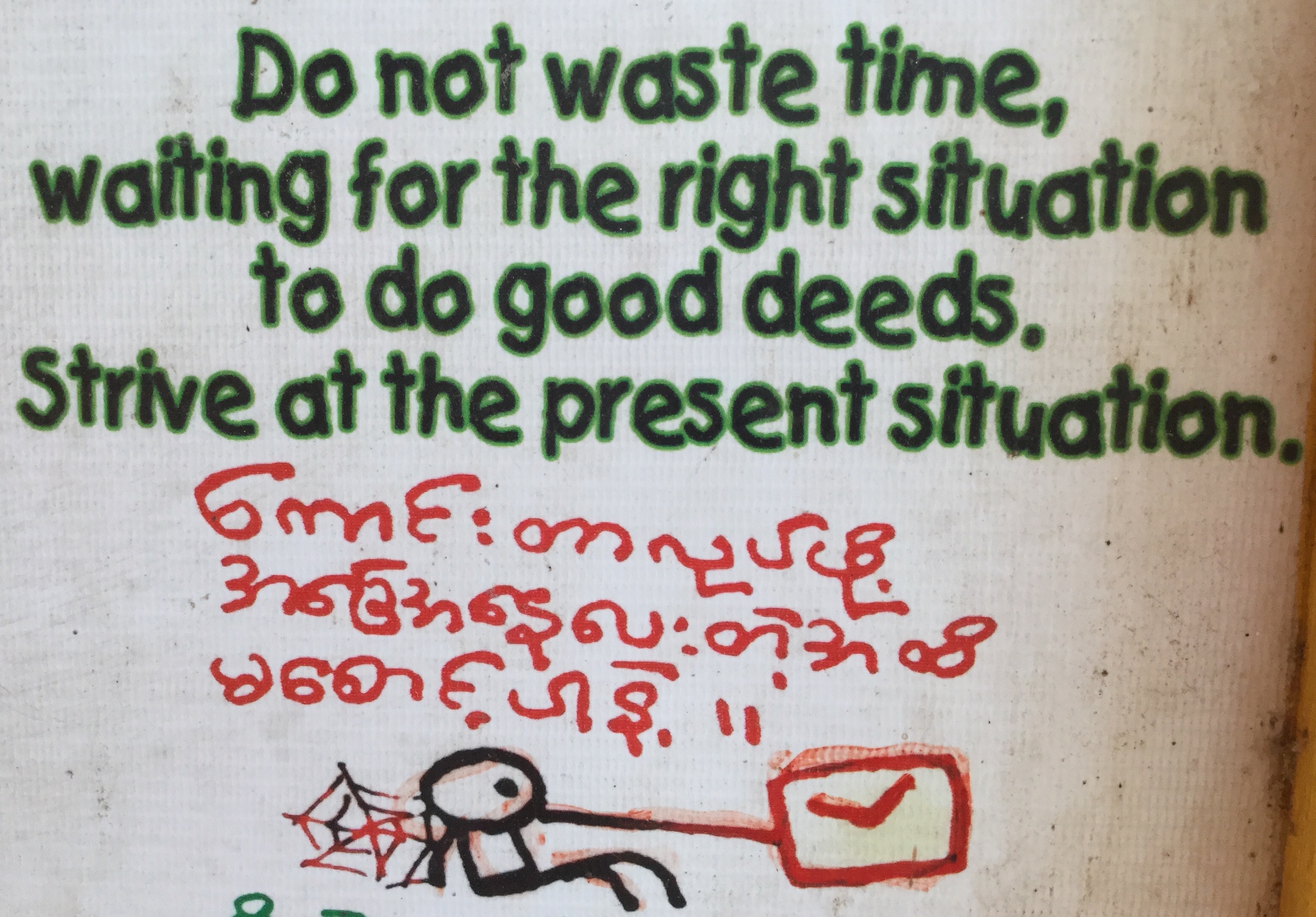

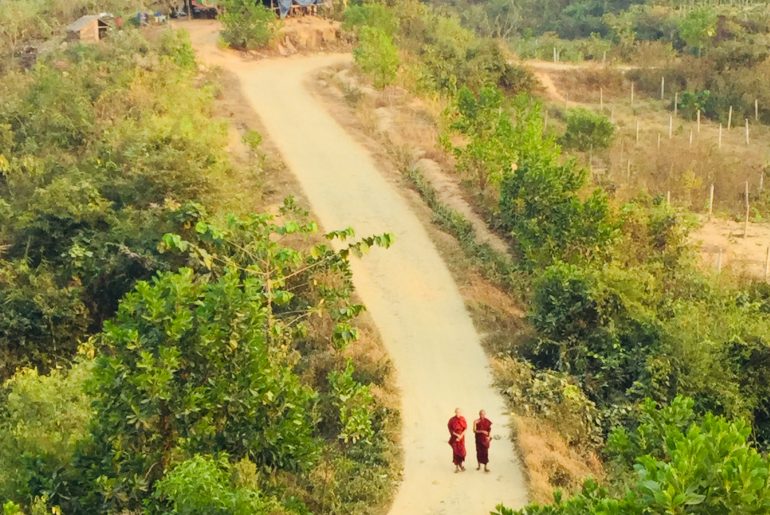
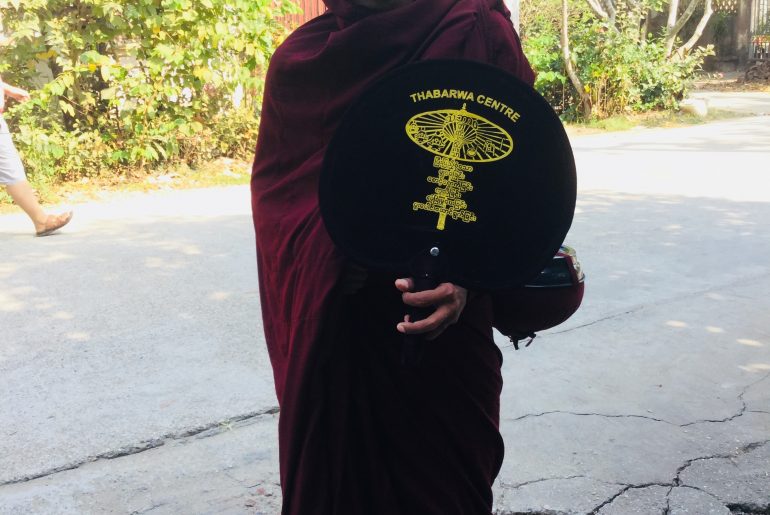
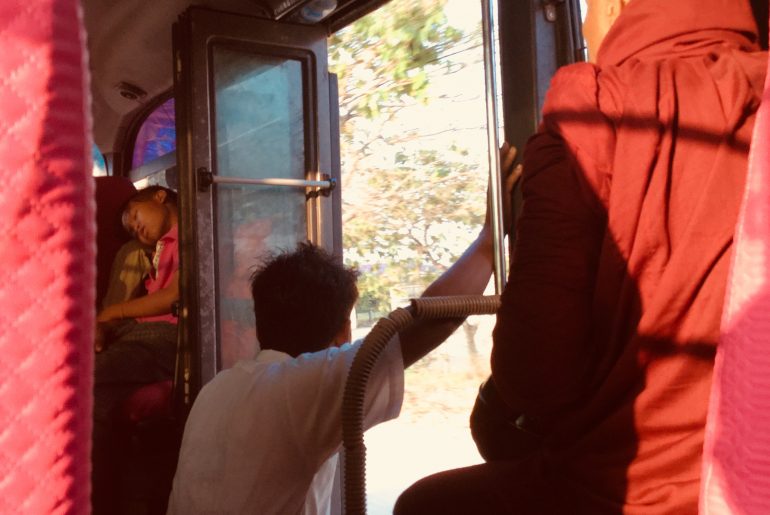
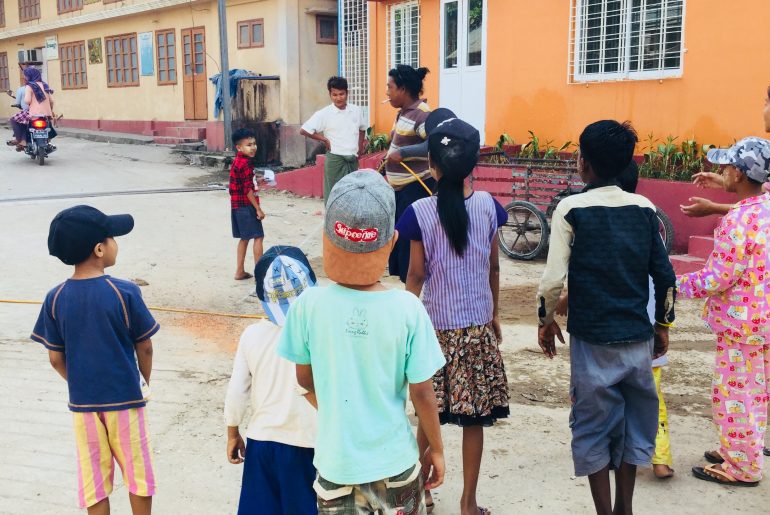
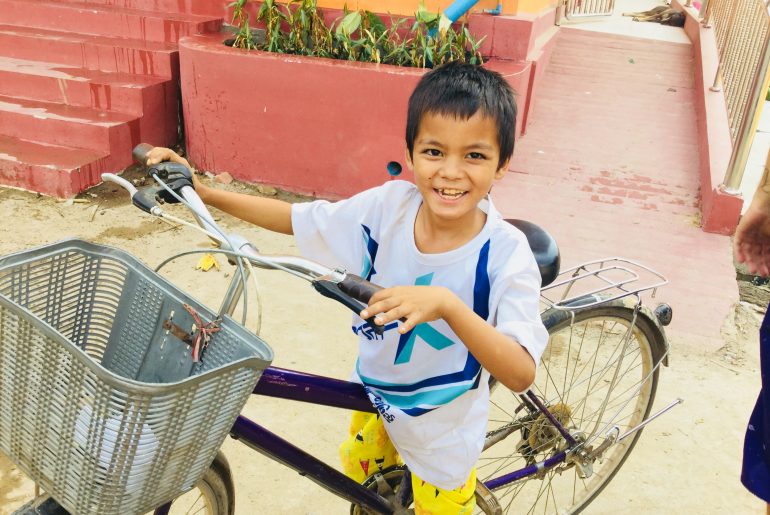
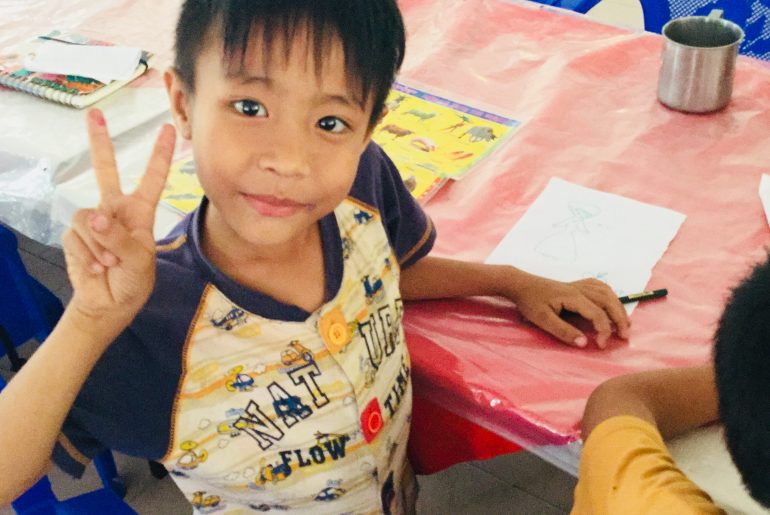
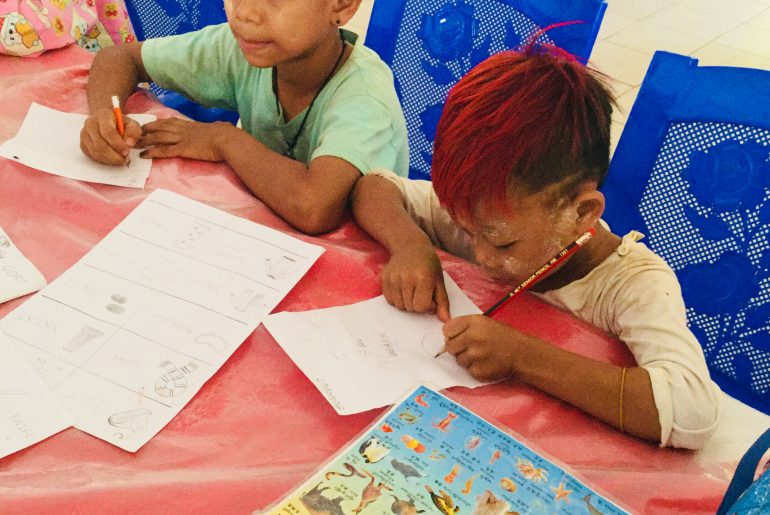
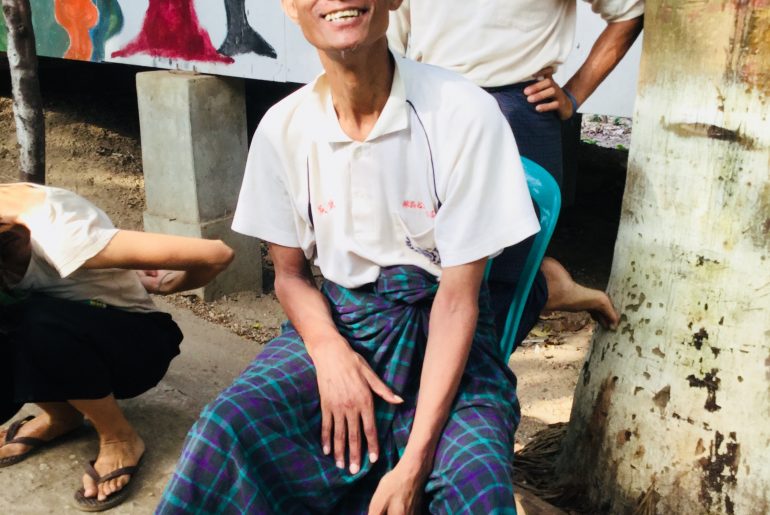
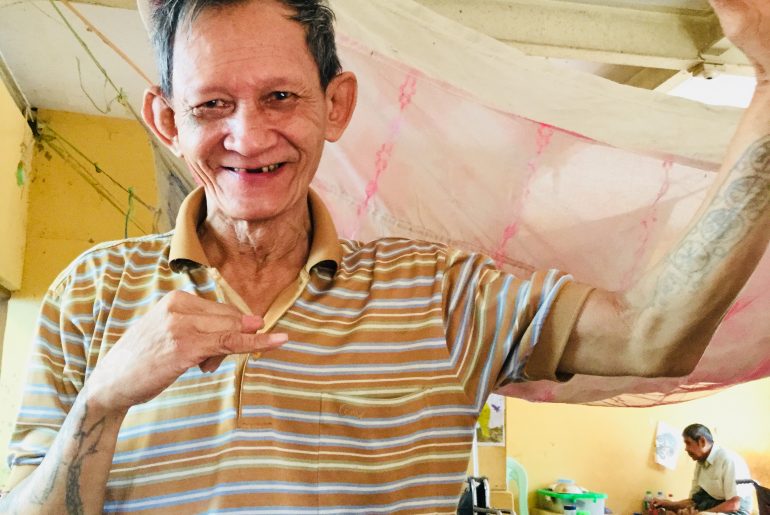
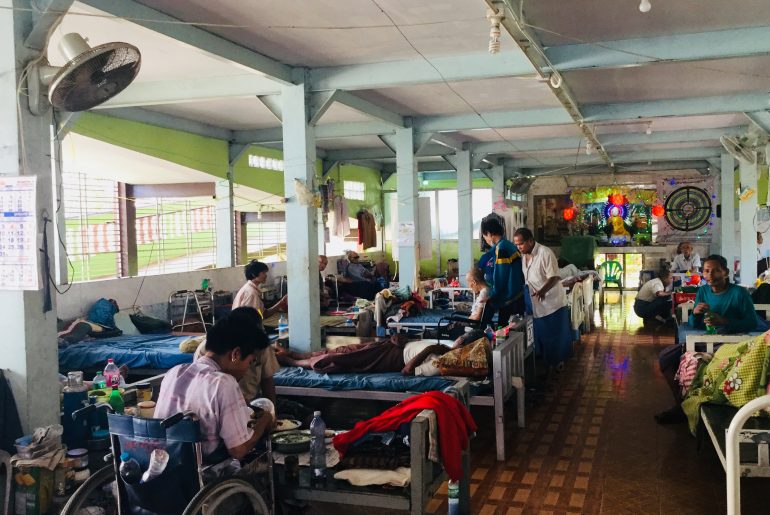
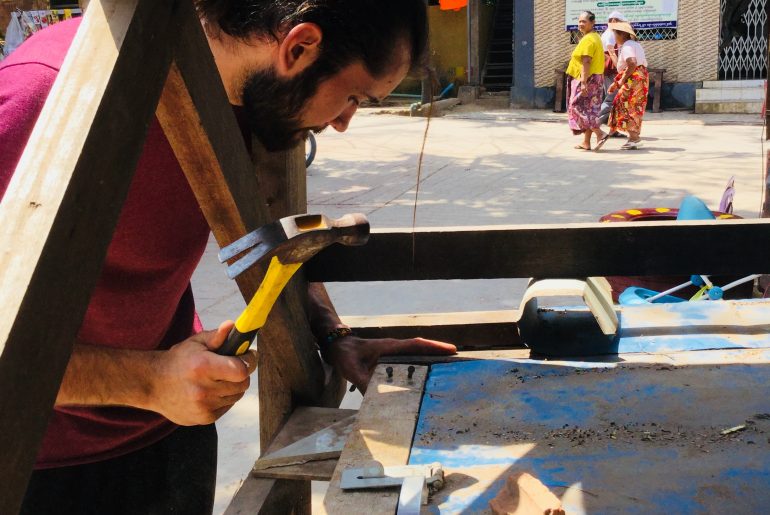
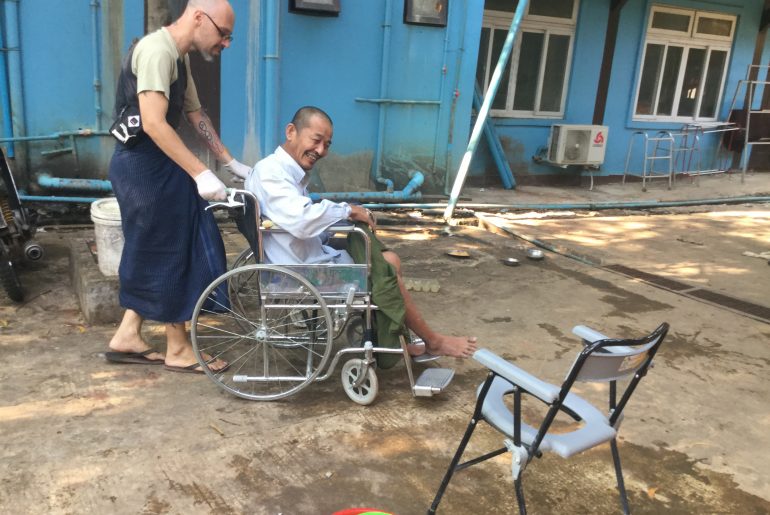
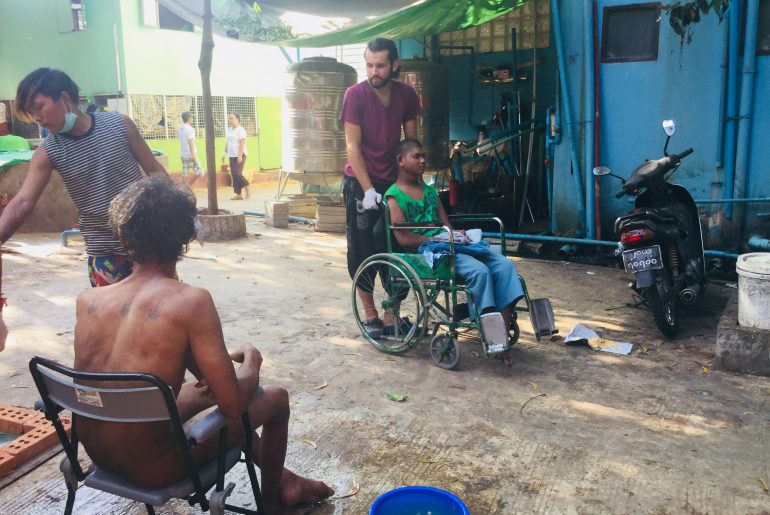
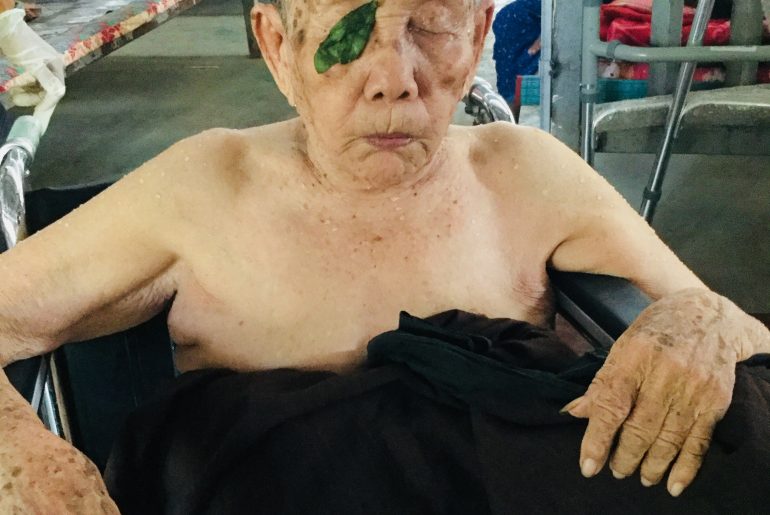
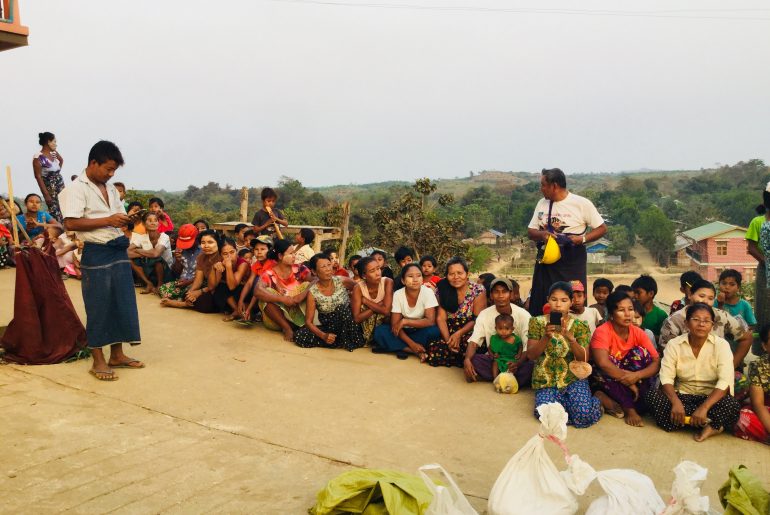
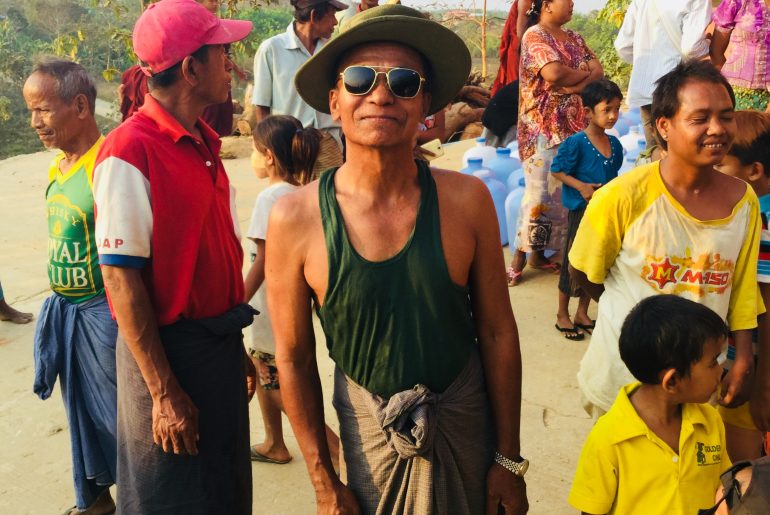

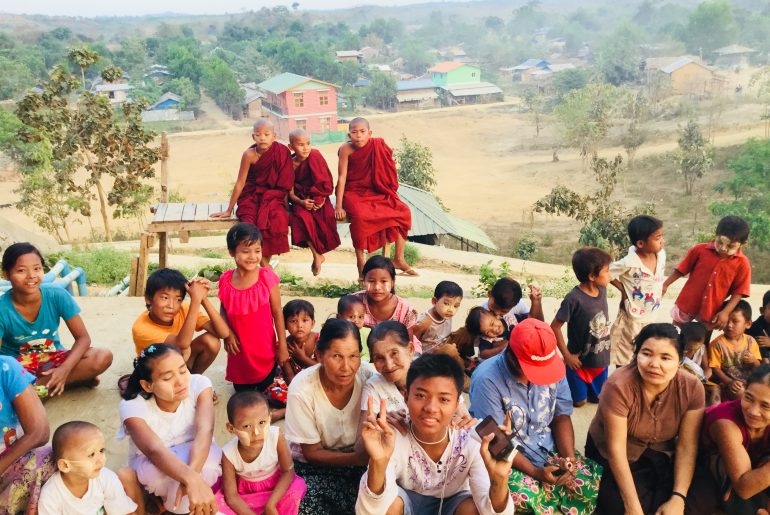
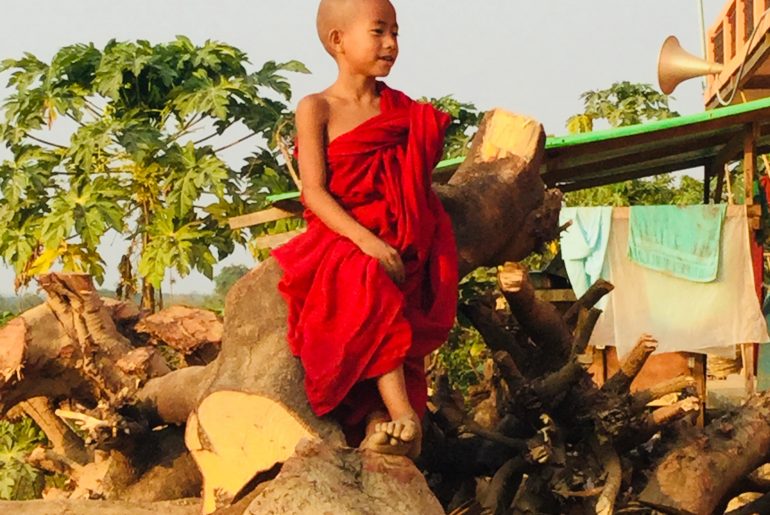
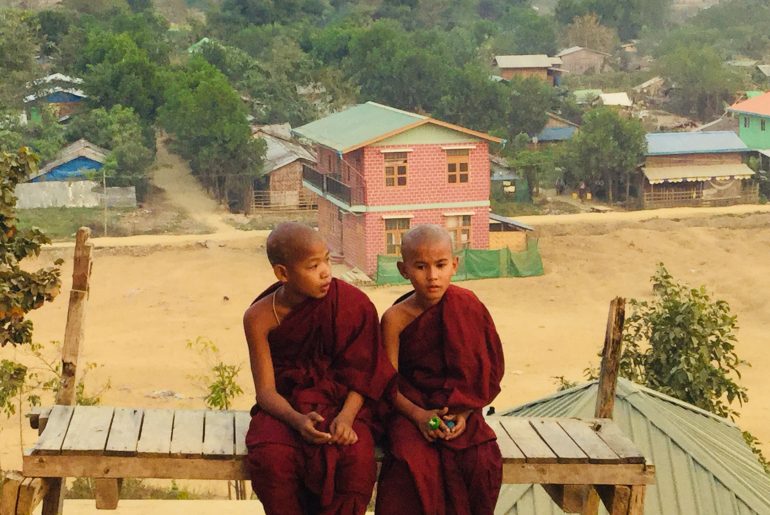
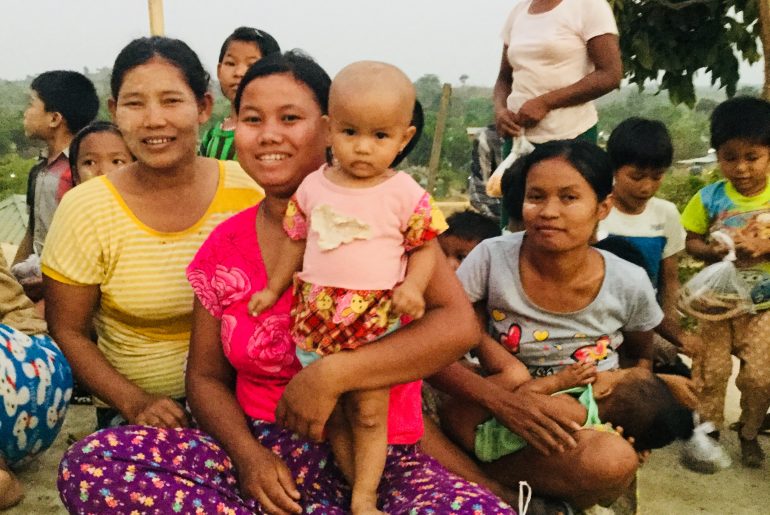
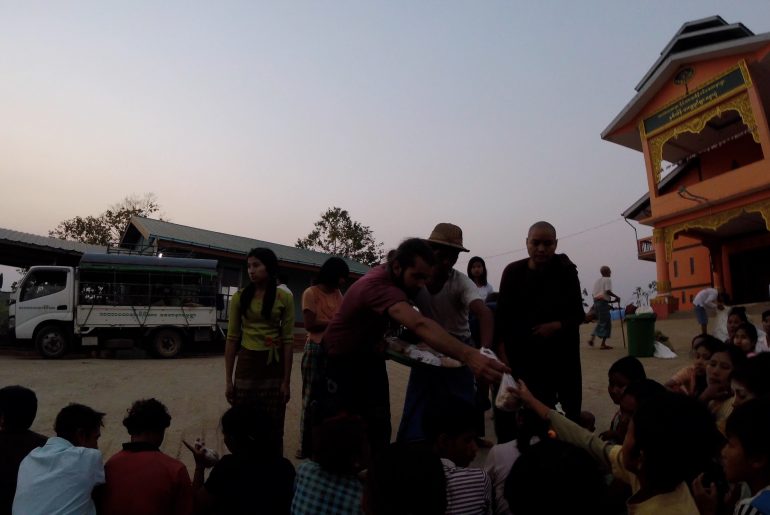

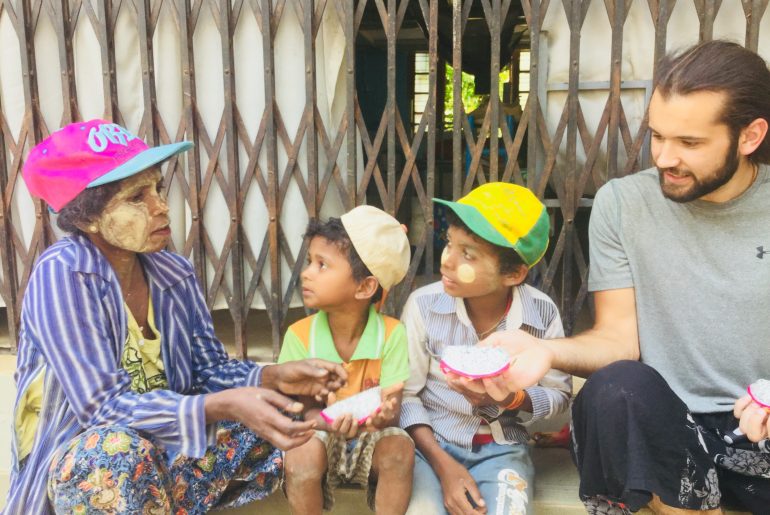
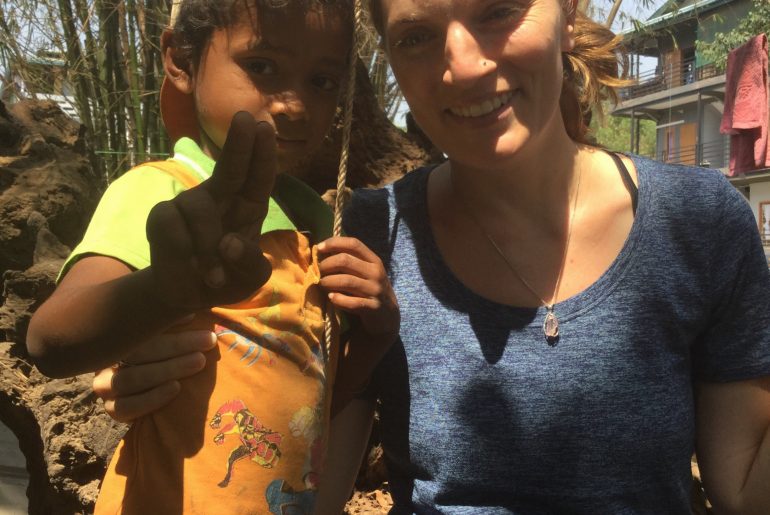
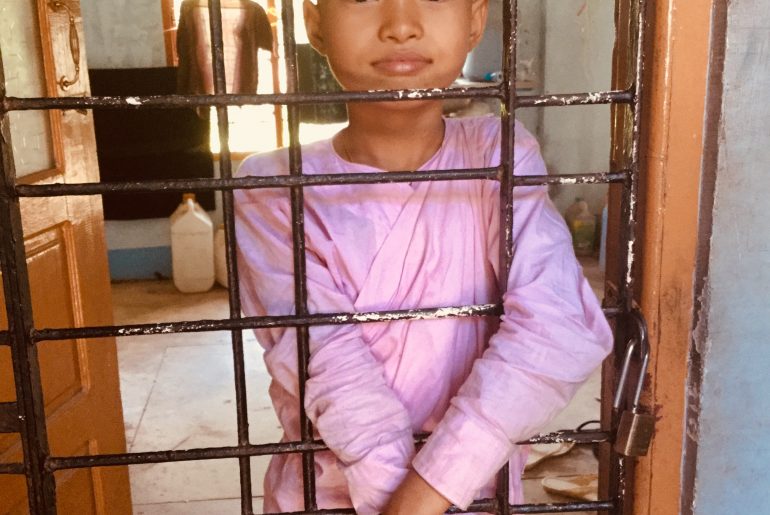
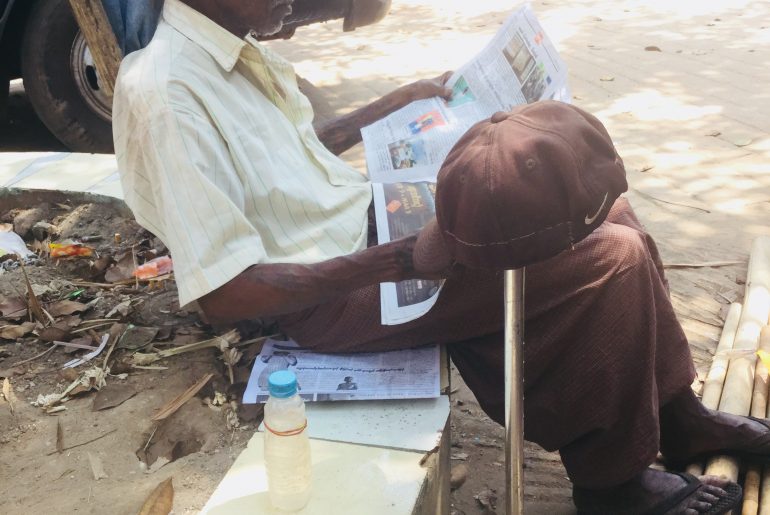

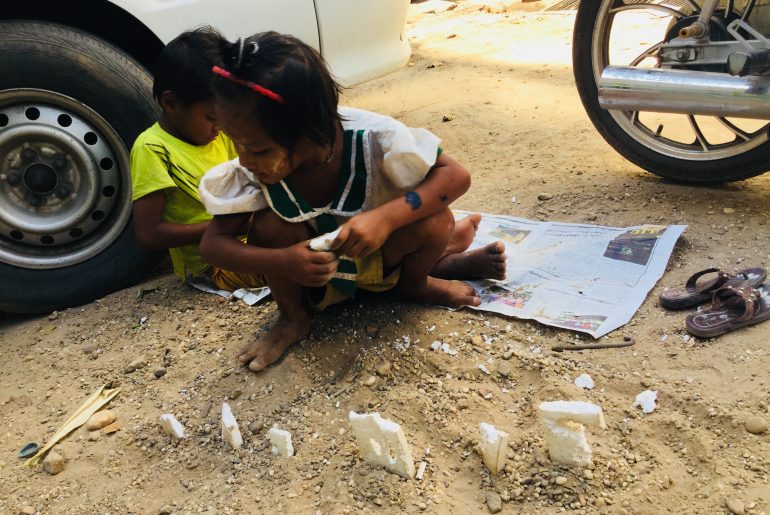
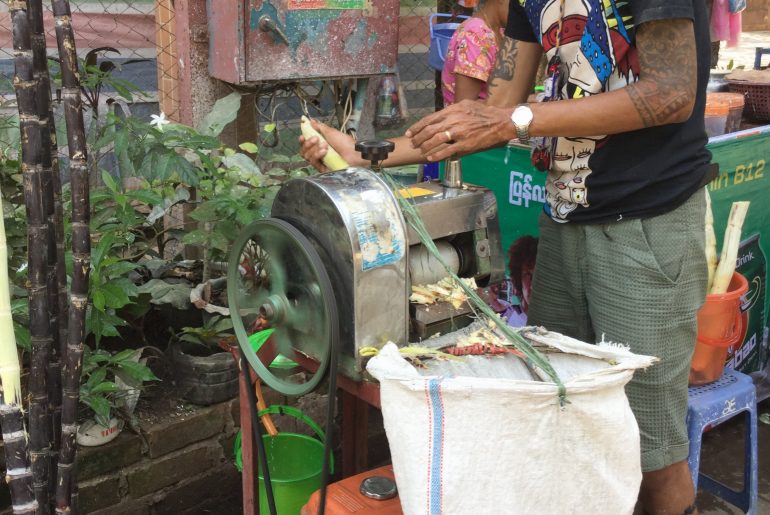
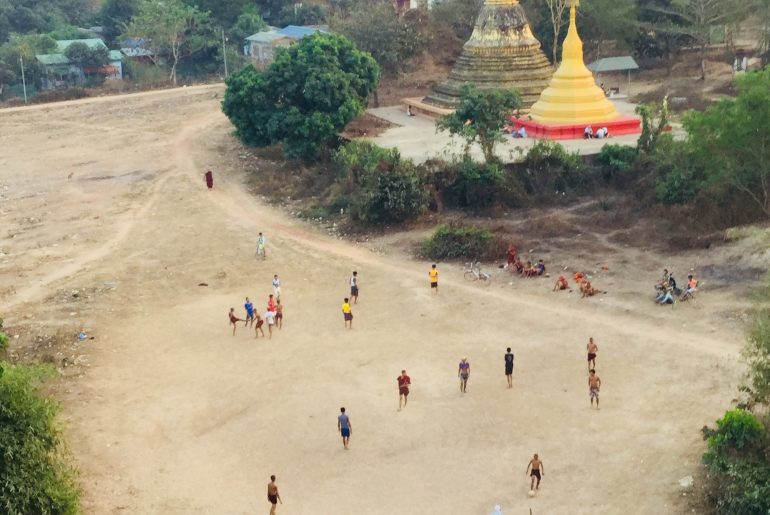
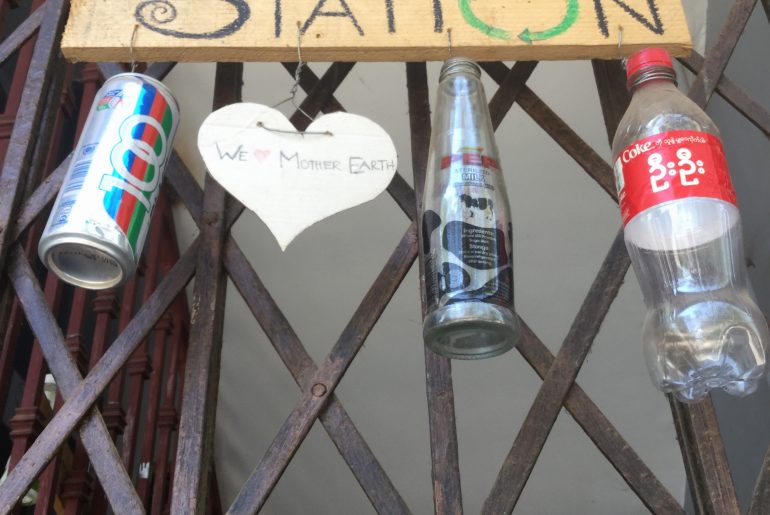
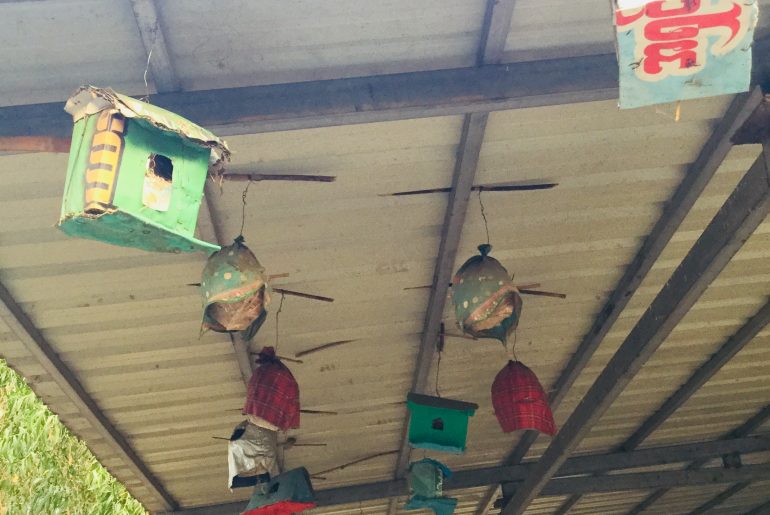
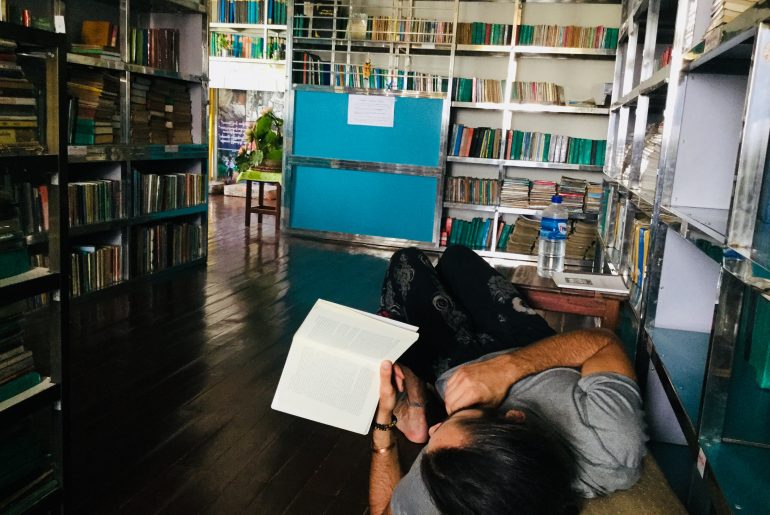
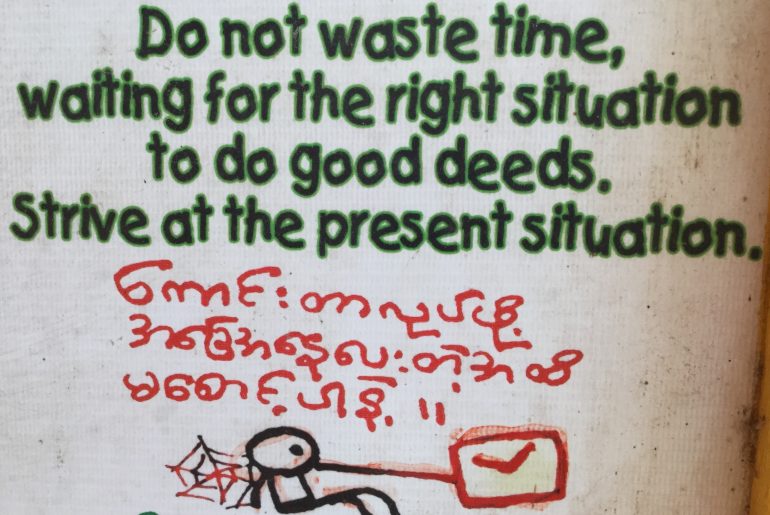
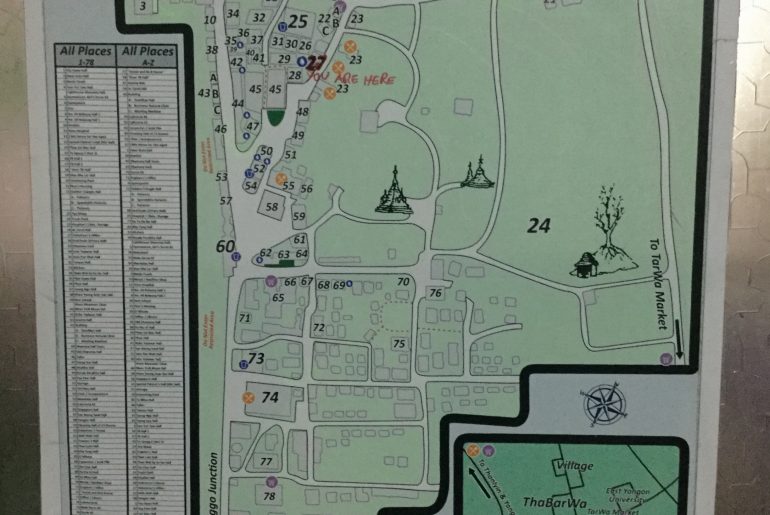
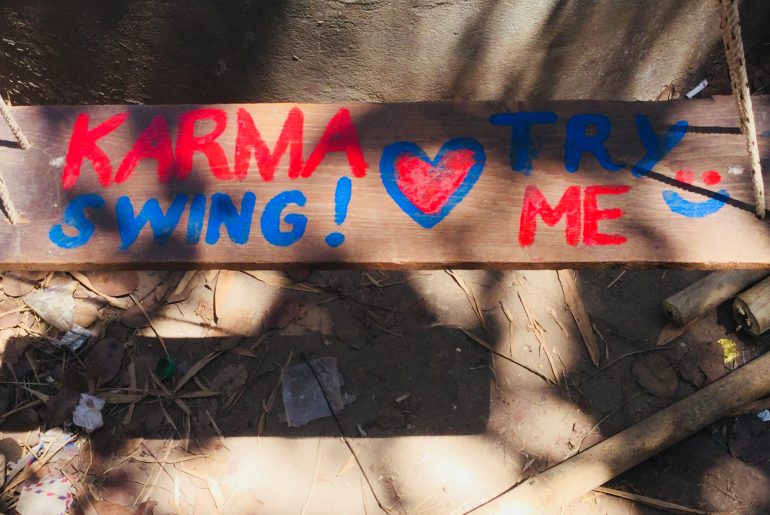
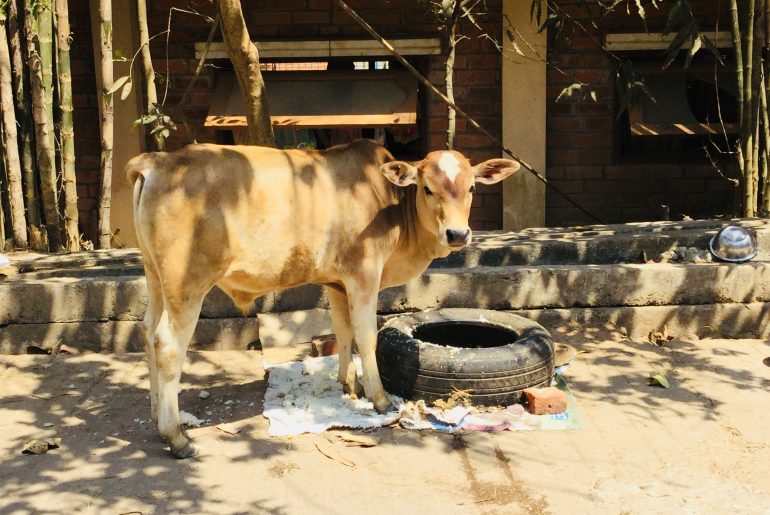
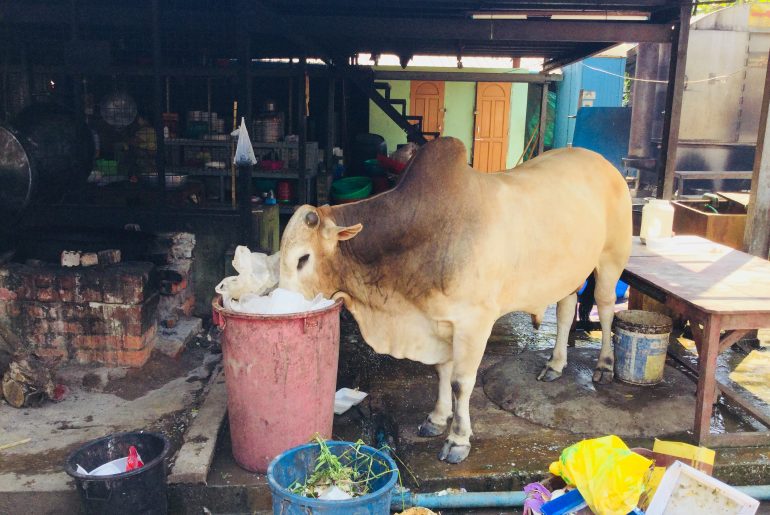
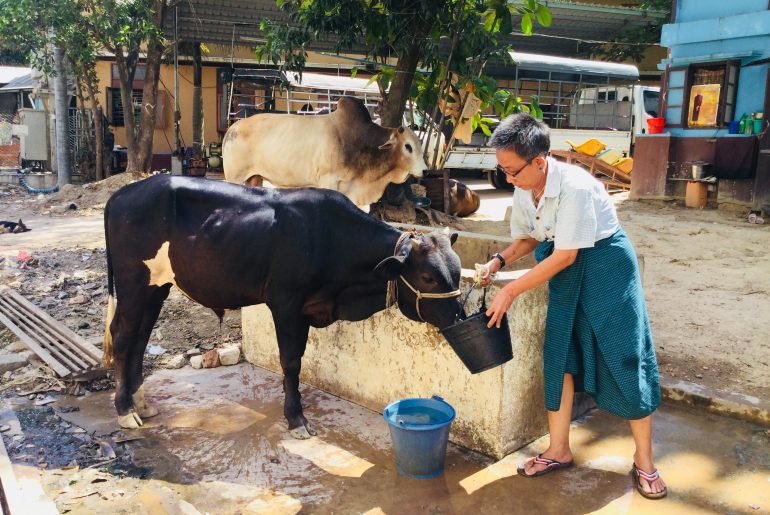
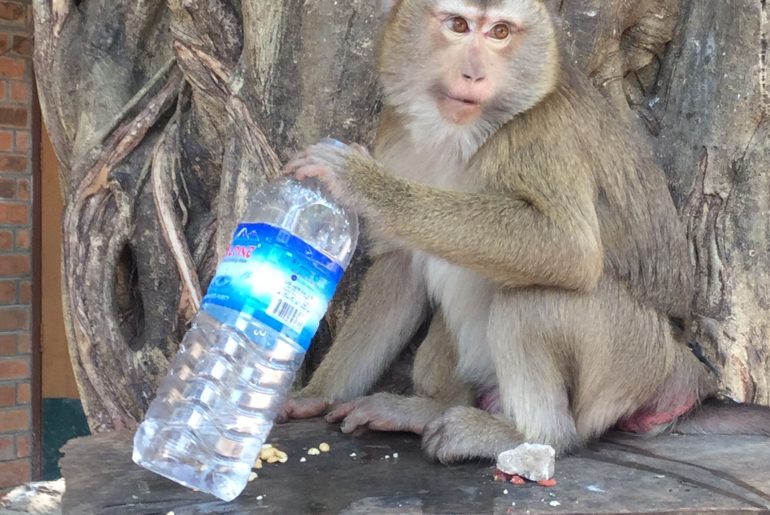
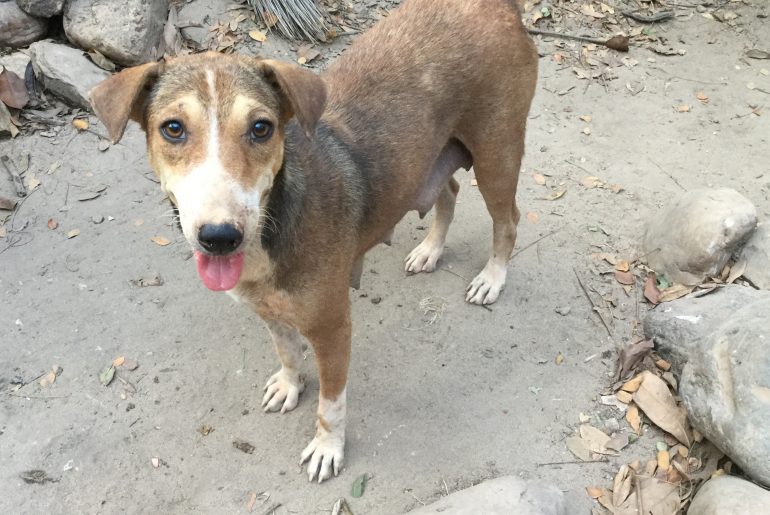
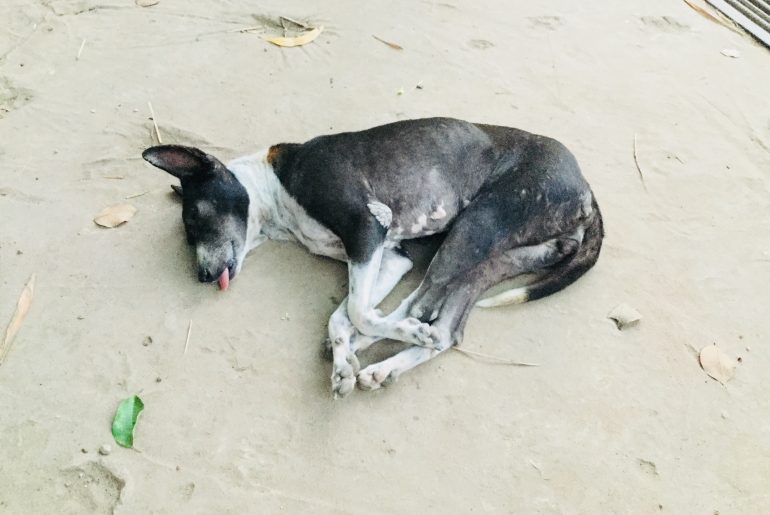
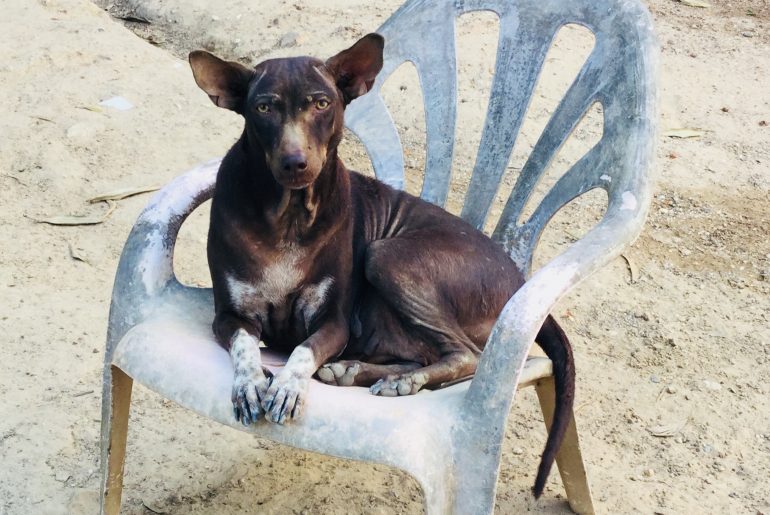
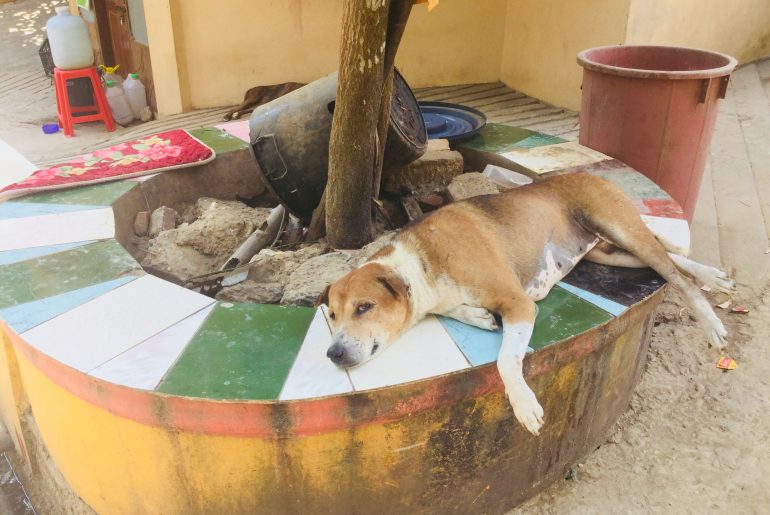
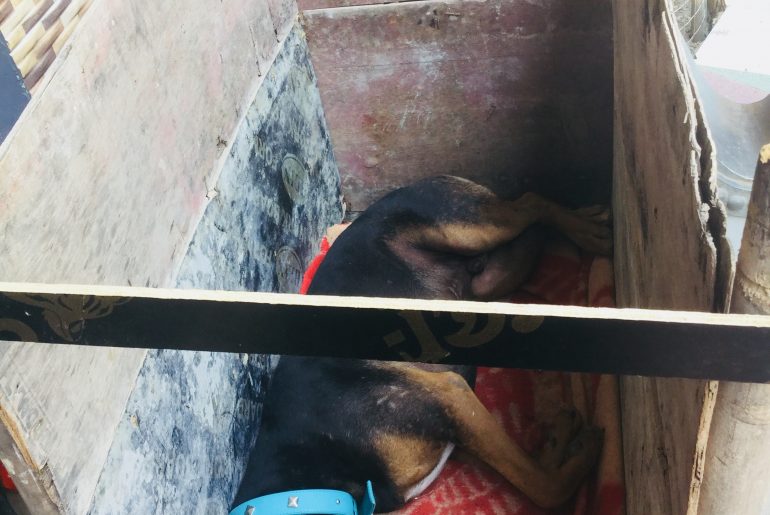
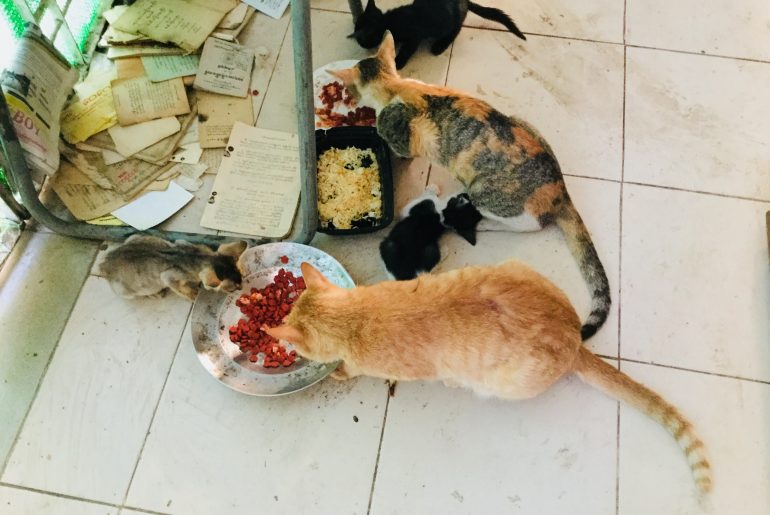
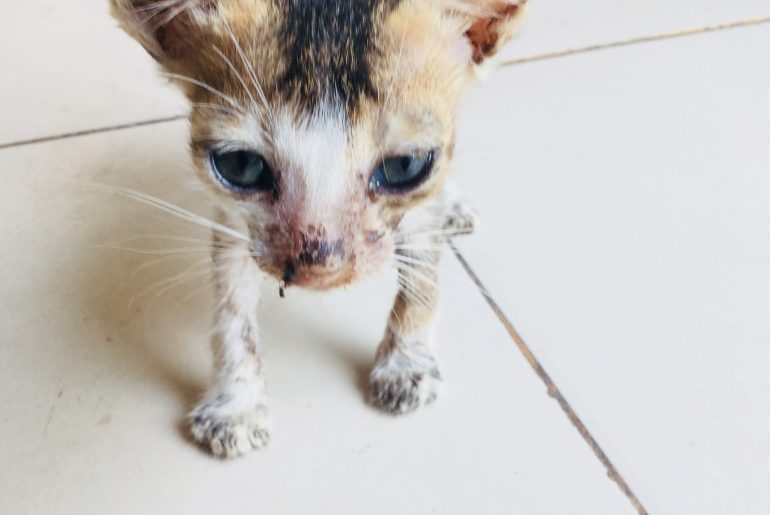
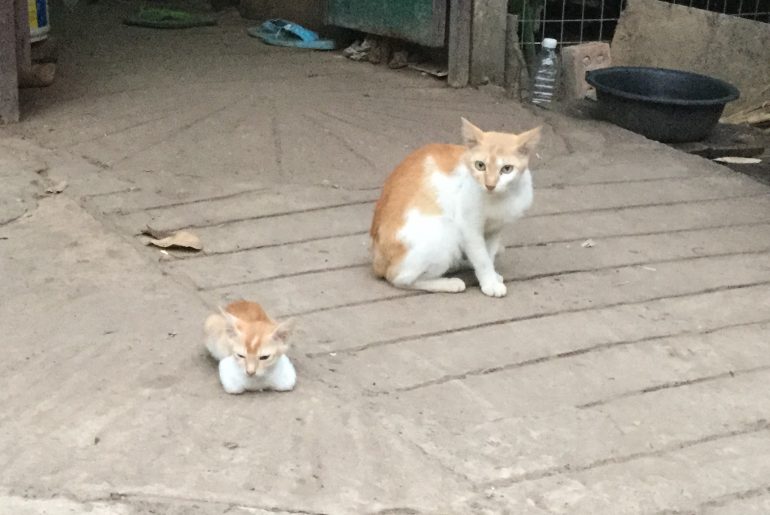
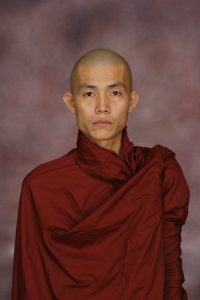 When we first arrived at the center we pulled up a roadway to what we thought would lead to a meditation building in a more secluded location. After arriving at the registration office we were guided on a tour around Thabarwa. We knew that many people were living here but it turned out that the center was pretty huge and there are around 3,500 people co-existing free of charge. They are given free dental, acupuncture, and healthcare and while volunteering you are given these benefits as well. The donations given through ALMS provide food and necessities for everyone. Over 600 pounds of white rice is cooked per day, making over 10,000 meals every day. You can read more about ALMS and other volunteer activities in the next post. The doors to Thabarwa are open to anyone and everyone, there are homeless, sick, dying, orphans and people whose families can no longer take care of them. Once the orphan children reach a certain age they become a nun or monk and at one point, they choose to continue their life as a monk or nun or go off on their own and live as an everyday Burmese person. Sayadaw Ottamasara is the Burmese monk who founded Thabarwa, his main purpose for creating the center is to have the opportunity to do good deeds and practice meditation. One night we were able to meet him, he is very humble and gentle. The fact that this center started with the sole purpose of just doing good deeds and taking care of each other truly shows the power of completing selfless acts. What was once a few small houses is now a large enough space to house thousands. There are also more of these same centers opening around the world with the same intentions. I was blown away by the fact that no one is turned away. No matter what your circumstance is, you are welcome at Thabarwa.
When we first arrived at the center we pulled up a roadway to what we thought would lead to a meditation building in a more secluded location. After arriving at the registration office we were guided on a tour around Thabarwa. We knew that many people were living here but it turned out that the center was pretty huge and there are around 3,500 people co-existing free of charge. They are given free dental, acupuncture, and healthcare and while volunteering you are given these benefits as well. The donations given through ALMS provide food and necessities for everyone. Over 600 pounds of white rice is cooked per day, making over 10,000 meals every day. You can read more about ALMS and other volunteer activities in the next post. The doors to Thabarwa are open to anyone and everyone, there are homeless, sick, dying, orphans and people whose families can no longer take care of them. Once the orphan children reach a certain age they become a nun or monk and at one point, they choose to continue their life as a monk or nun or go off on their own and live as an everyday Burmese person. Sayadaw Ottamasara is the Burmese monk who founded Thabarwa, his main purpose for creating the center is to have the opportunity to do good deeds and practice meditation. One night we were able to meet him, he is very humble and gentle. The fact that this center started with the sole purpose of just doing good deeds and taking care of each other truly shows the power of completing selfless acts. What was once a few small houses is now a large enough space to house thousands. There are also more of these same centers opening around the world with the same intentions. I was blown away by the fact that no one is turned away. No matter what your circumstance is, you are welcome at Thabarwa.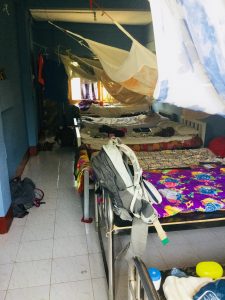 Volunteers are hosted in separate male and female dorms and provided with bed linen, mosquito nets, and security lockers. Breakfast and lunch are provided by the center and a kitchen is available for the volunteers to prepare the dinner together. Filtered water is available free throughout the center but a fellow volunteer guided us to the”cleanest” water at the center and told us we should only drink from that one. There are also several restaurants and tea shops in the center for any extra needs that you might have. Throughout the day everyone gathers to drink tea and watch the large television, even the monks. One night while Jesse and I were eating dinner and they had Titanic playing.
Volunteers are hosted in separate male and female dorms and provided with bed linen, mosquito nets, and security lockers. Breakfast and lunch are provided by the center and a kitchen is available for the volunteers to prepare the dinner together. Filtered water is available free throughout the center but a fellow volunteer guided us to the”cleanest” water at the center and told us we should only drink from that one. There are also several restaurants and tea shops in the center for any extra needs that you might have. Throughout the day everyone gathers to drink tea and watch the large television, even the monks. One night while Jesse and I were eating dinner and they had Titanic playing.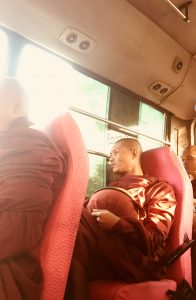 There are over 500,000 Buddhist monks in Myanmar. They wear saffron-colored or rust-colored robes and the nuns wear pink robes that represent sunshine. In order to remain a monk at a monastery, they have 227 rules to follow. I encourage you to research them, some are quite ridiculous. Many of the monks and nuns at Thabarwa are for lack of better word, rebels. They didn’t follow all of the rules so they were asked to leave their monasteries and since Thabarwa accepts all as they are, many decided to settle at the center. At first, seeing monks smoking cigars and watching T.V. made me confused, but over time it became normal. Even when Jesse and I did the ALMS you could see that during the actual act of collecting donations the monks were very proper but as soon as we got on the bus they became a little more like normal everyday Burmese people and their posture relaxed more. I began wondering what it might be like when they were altogether alone without volunteers around, just monks. A fraternity image came to mind of a bunch of guys just laughing and having a good time, minus the alcohol. Some of them even have nicer phones than all of the volunteers. With them having no income it makes you wonder where they are getting the money for a huge fancy cell phone, but I am not here to judge, I’m just speaking my observations.
There are over 500,000 Buddhist monks in Myanmar. They wear saffron-colored or rust-colored robes and the nuns wear pink robes that represent sunshine. In order to remain a monk at a monastery, they have 227 rules to follow. I encourage you to research them, some are quite ridiculous. Many of the monks and nuns at Thabarwa are for lack of better word, rebels. They didn’t follow all of the rules so they were asked to leave their monasteries and since Thabarwa accepts all as they are, many decided to settle at the center. At first, seeing monks smoking cigars and watching T.V. made me confused, but over time it became normal. Even when Jesse and I did the ALMS you could see that during the actual act of collecting donations the monks were very proper but as soon as we got on the bus they became a little more like normal everyday Burmese people and their posture relaxed more. I began wondering what it might be like when they were altogether alone without volunteers around, just monks. A fraternity image came to mind of a bunch of guys just laughing and having a good time, minus the alcohol. Some of them even have nicer phones than all of the volunteers. With them having no income it makes you wonder where they are getting the money for a huge fancy cell phone, but I am not here to judge, I’m just speaking my observations.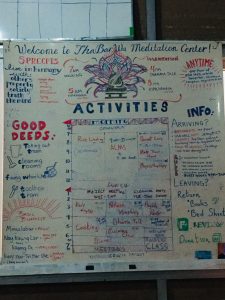 Every night at the center there is a volunteer meeting where you decide which activities you want to participate in the following day. The number of volunteers changes often, people are coming and going daily but you can have anywhere between 25-60 volunteers at a time. People from all over the world come to Thabarwa to volunteer their time and we had the chance to meet many other travelers during our 2-week stay. Typically volunteers usually stay 3-7 days and often people leave and return at a later date. Each volunteer is free to participate in any activity they want, even if they have never done it before there is always someone in charge guiding and teaching you. The main idea is to practice good deeds and to push yourself out of your comfort zone to try things that you normally wouldn’t try, simply because its the right thing to do and its needed. Volunteers can also propose and organize new projects if they have any skills that can be useful for the benefit of the center and its residents. I was told that in Burma as a foreigner if you’d like to try out being a nun or monk you can in a matter of minutes. No long process, you shave your head and slowly learn the ways. When and if you decide it’s not for you, you can pack your bags and leave. I also heard that you can buy robes off the street and disguise yourself as a monk. Majority of Burmese wouldn’t do this because they believe in Karma but it has definitely been done before.
Every night at the center there is a volunteer meeting where you decide which activities you want to participate in the following day. The number of volunteers changes often, people are coming and going daily but you can have anywhere between 25-60 volunteers at a time. People from all over the world come to Thabarwa to volunteer their time and we had the chance to meet many other travelers during our 2-week stay. Typically volunteers usually stay 3-7 days and often people leave and return at a later date. Each volunteer is free to participate in any activity they want, even if they have never done it before there is always someone in charge guiding and teaching you. The main idea is to practice good deeds and to push yourself out of your comfort zone to try things that you normally wouldn’t try, simply because its the right thing to do and its needed. Volunteers can also propose and organize new projects if they have any skills that can be useful for the benefit of the center and its residents. I was told that in Burma as a foreigner if you’d like to try out being a nun or monk you can in a matter of minutes. No long process, you shave your head and slowly learn the ways. When and if you decide it’s not for you, you can pack your bags and leave. I also heard that you can buy robes off the street and disguise yourself as a monk. Majority of Burmese wouldn’t do this because they believe in Karma but it has definitely been done before.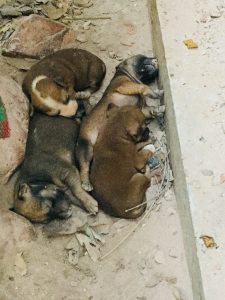 The dogs here have packs and at night they are either all howling together beautifully or fighting. Although, there are moments when it’s complete silence and everyone and everything is resting. If the dogs see you walking at night through their territory especially if it’s on the dirt paths they may circle you. They don’t like some of the Burmese people, most likely the ones that taunt them and they are still getting used to foreigners so they can be very territorial. It may be a good idea to keep an eye on the nearest stick just Incase you need to protect yourself. There are also some dogs that are very sweet. You can tell which ones are ok to touch by their wagging tails, smiles and overall posture. They are all very dirty, have fleas, scars and skin conditions but as long as you wash your hands after you have nothing to worry about. This center is a home for everyone, the sick, dying, homeless, lonely and poor and it’s interesting because even the dogs that wander in here seeking refuge may have cancer or other illnesses. Its as if they understand that this is a safe zone for them to live where they know they will be fed and taken care of. There are also some smaller puppies maybe a few months old and some newborn puppies. The momma dog with the newborns is very protective of them towards the other dogs but towards people, she is generally very sweet. They are in a special caged in area for their protection and there’s a hole in the cage that the momma can jump through to get out.
The dogs here have packs and at night they are either all howling together beautifully or fighting. Although, there are moments when it’s complete silence and everyone and everything is resting. If the dogs see you walking at night through their territory especially if it’s on the dirt paths they may circle you. They don’t like some of the Burmese people, most likely the ones that taunt them and they are still getting used to foreigners so they can be very territorial. It may be a good idea to keep an eye on the nearest stick just Incase you need to protect yourself. There are also some dogs that are very sweet. You can tell which ones are ok to touch by their wagging tails, smiles and overall posture. They are all very dirty, have fleas, scars and skin conditions but as long as you wash your hands after you have nothing to worry about. This center is a home for everyone, the sick, dying, homeless, lonely and poor and it’s interesting because even the dogs that wander in here seeking refuge may have cancer or other illnesses. Its as if they understand that this is a safe zone for them to live where they know they will be fed and taken care of. There are also some smaller puppies maybe a few months old and some newborn puppies. The momma dog with the newborns is very protective of them towards the other dogs but towards people, she is generally very sweet. They are in a special caged in area for their protection and there’s a hole in the cage that the momma can jump through to get out.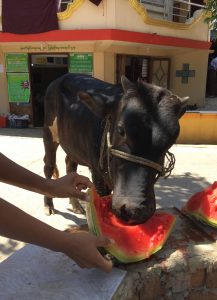 There originally was one bull that wandered in but now there are a dozen large cattle. Apparently, a rich Indian man owns them, he must live nearby because they wander in often for watermelon, bananas, and rice. They walk down the road together and often eat out of the trash or designated spots where food is left in tires for them. They come in the morning, eat and relax in the shade and then I’m assuming they make the venture back home. Although they are very large and intimidating, they are quite friendly.
There originally was one bull that wandered in but now there are a dozen large cattle. Apparently, a rich Indian man owns them, he must live nearby because they wander in often for watermelon, bananas, and rice. They walk down the road together and often eat out of the trash or designated spots where food is left in tires for them. They come in the morning, eat and relax in the shade and then I’m assuming they make the venture back home. Although they are very large and intimidating, they are quite friendly.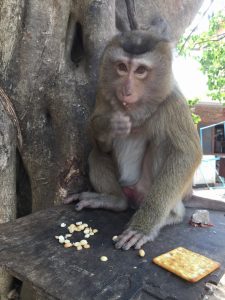 There’s one monkey, she’s chained up to a tree and throughout the day people give her food and water. It wasn’t until our third day here that I found out there was a monkey about 20 feet from our dorm. When I went to see her I saw that she was chained up and felt pretty sad for her. Apparently, the story is that she was once free and when the center began expanding she started going into rooms and throwing peoples personal belongings out the windows. They gave her one more chance and she continued, they knew she wanted to stay here at the center, probably because it was her home first, so they chained her up. I often brought her nuts, bananas, and water. Although she has her own tree house you can see that she is very bored, one time she tried taking my bracelet because it was shiny. She’s friendly but has her moments so you need to be cautious, she came at me once almost biting me after trying to give her a second drink of water. Her home is in a stressful location for her, at night and throughout the day the dogs often fight right at her tree so I think she’s beginning to have anxiety. I was so close to letting her loose, but this is one of those situations where unfortunately you have to detach and just walk away.
There’s one monkey, she’s chained up to a tree and throughout the day people give her food and water. It wasn’t until our third day here that I found out there was a monkey about 20 feet from our dorm. When I went to see her I saw that she was chained up and felt pretty sad for her. Apparently, the story is that she was once free and when the center began expanding she started going into rooms and throwing peoples personal belongings out the windows. They gave her one more chance and she continued, they knew she wanted to stay here at the center, probably because it was her home first, so they chained her up. I often brought her nuts, bananas, and water. Although she has her own tree house you can see that she is very bored, one time she tried taking my bracelet because it was shiny. She’s friendly but has her moments so you need to be cautious, she came at me once almost biting me after trying to give her a second drink of water. Her home is in a stressful location for her, at night and throughout the day the dogs often fight right at her tree so I think she’s beginning to have anxiety. I was so close to letting her loose, but this is one of those situations where unfortunately you have to detach and just walk away.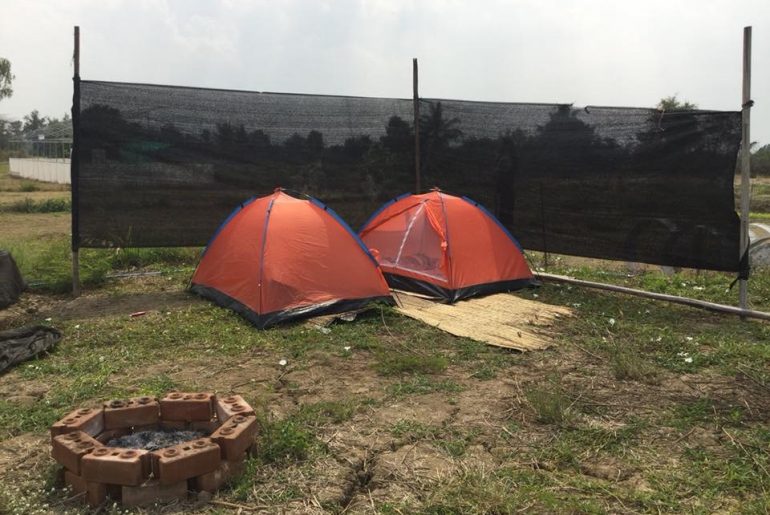
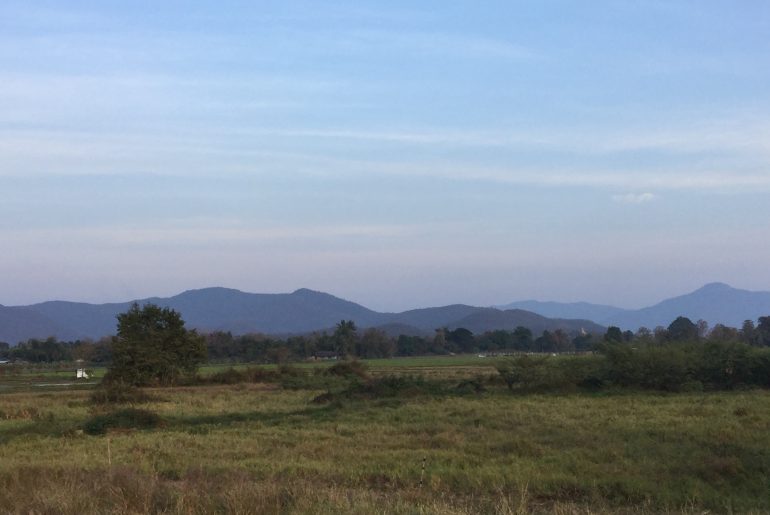
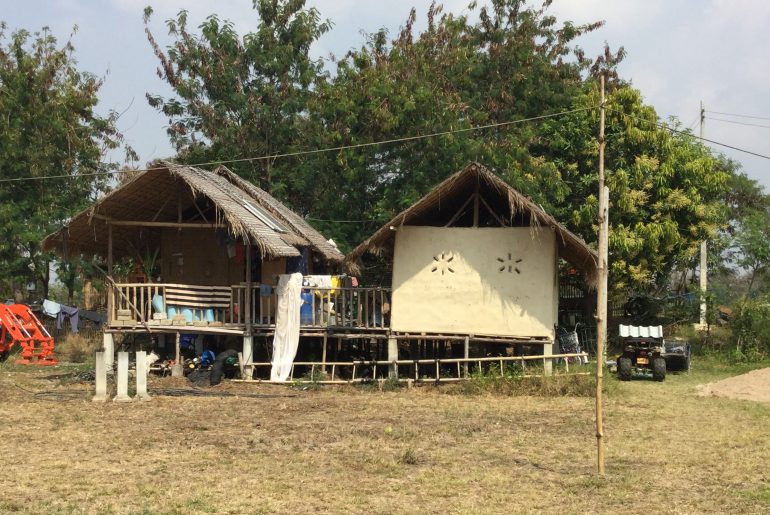
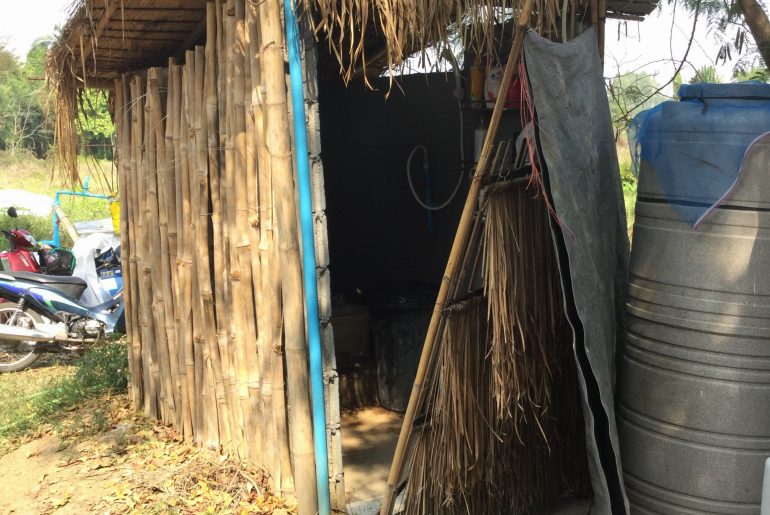
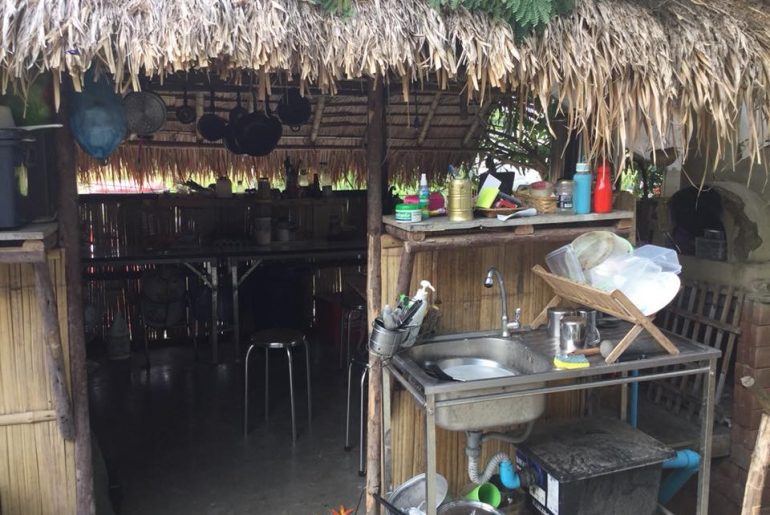
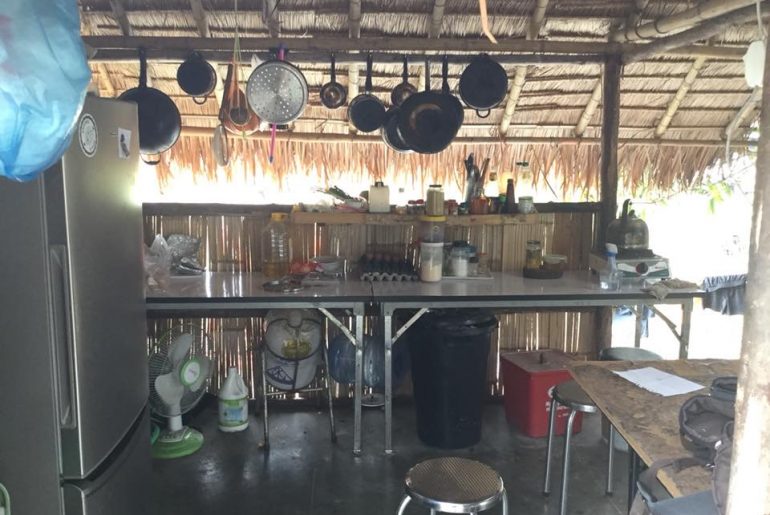
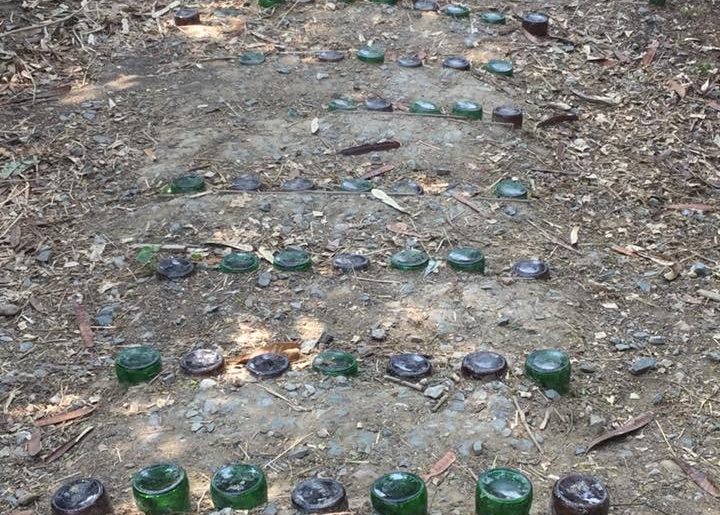
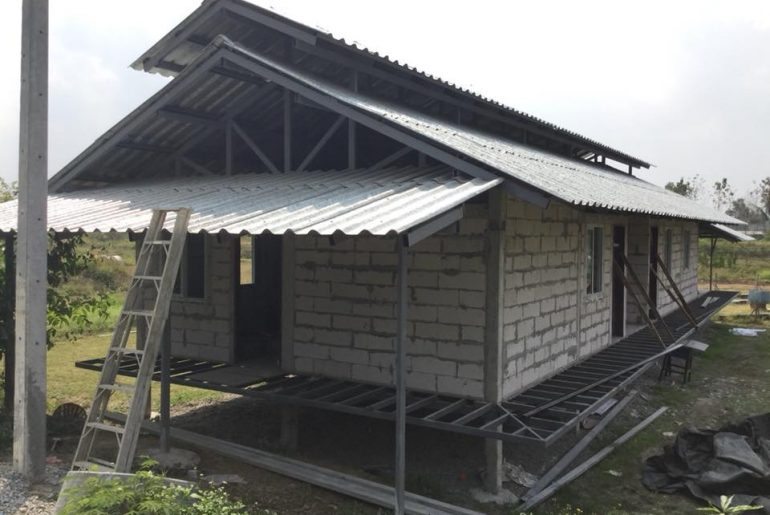
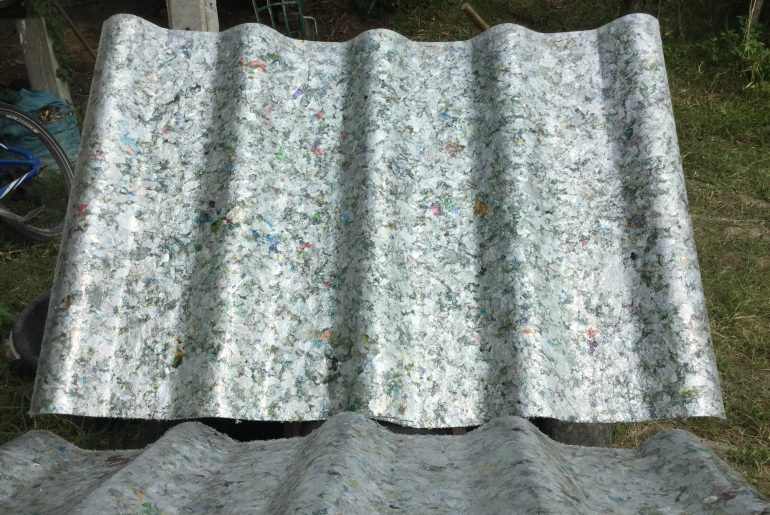

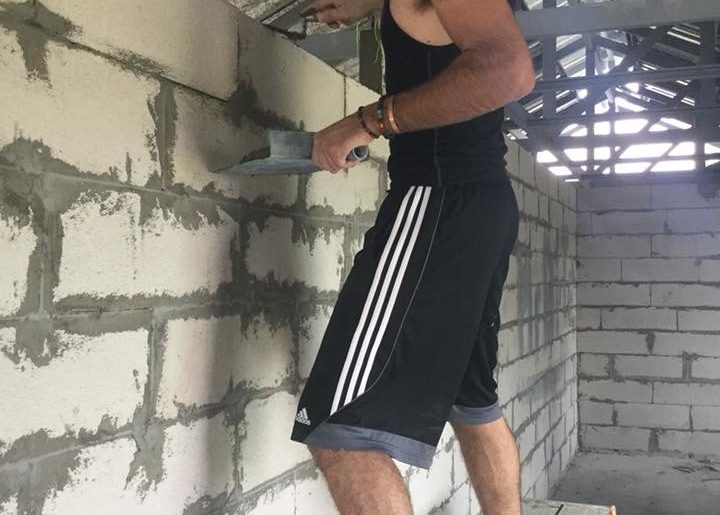
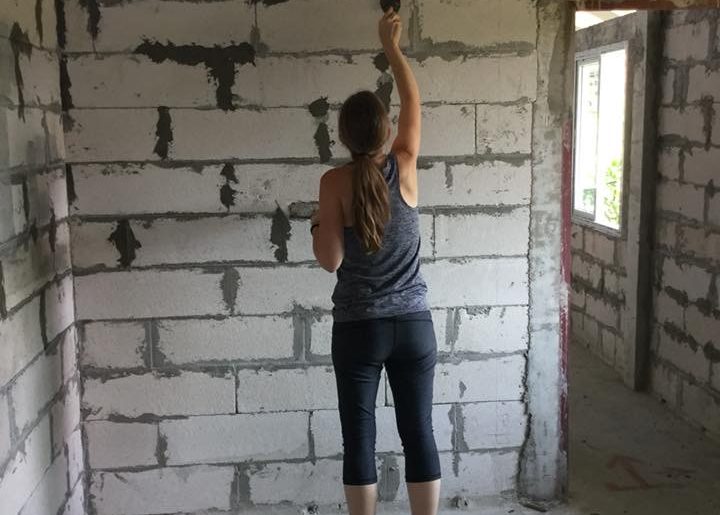
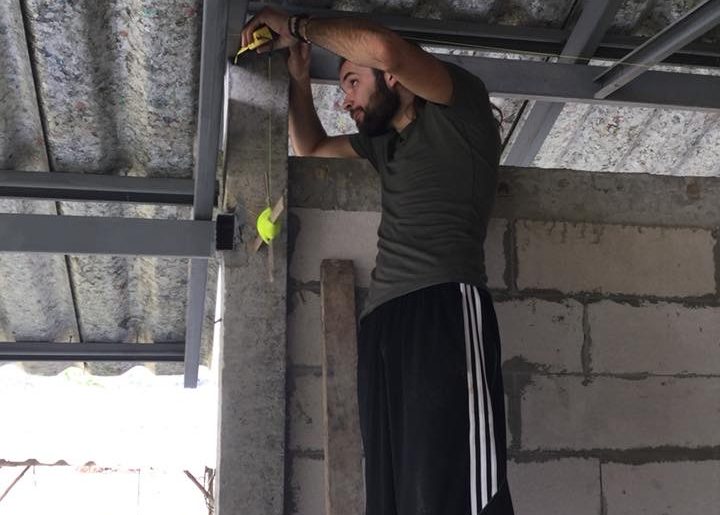
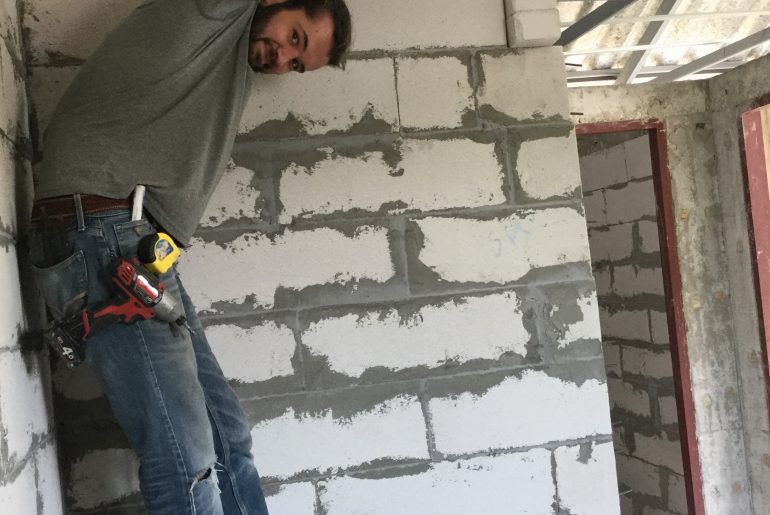
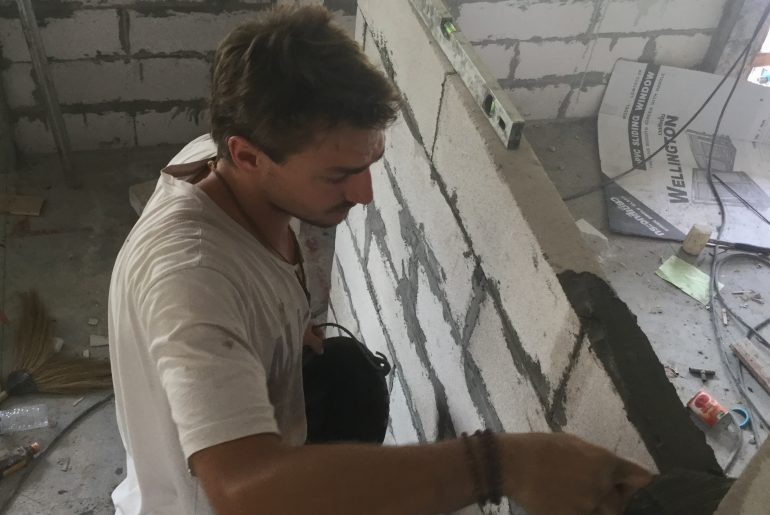
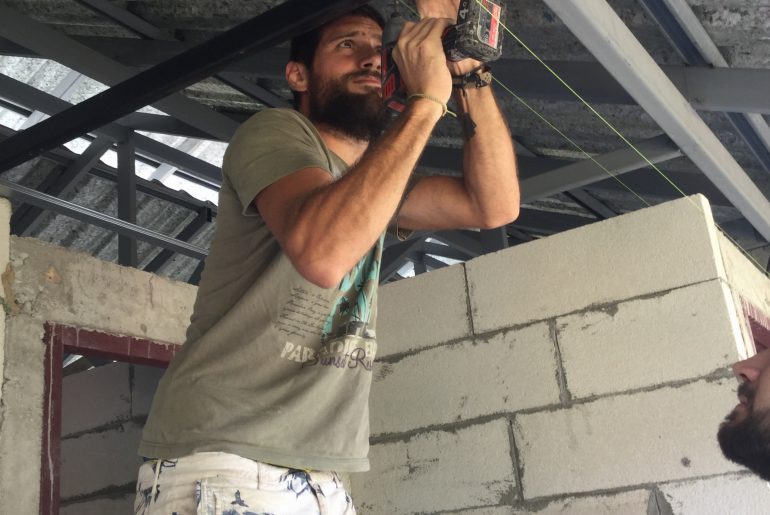
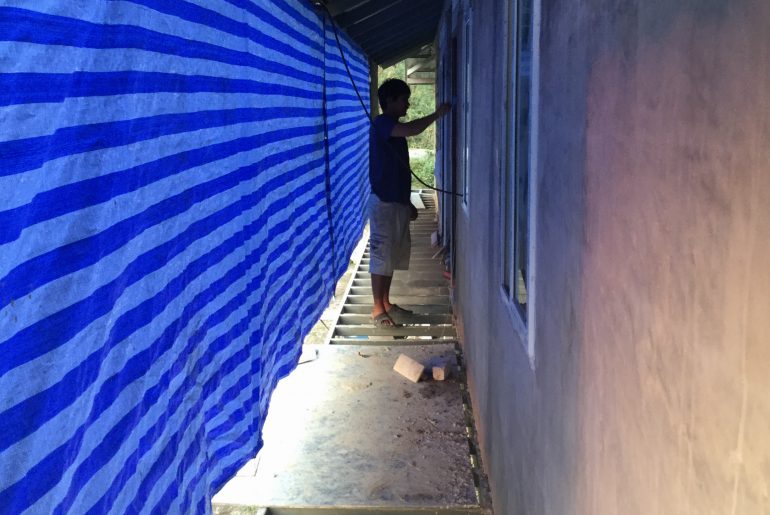

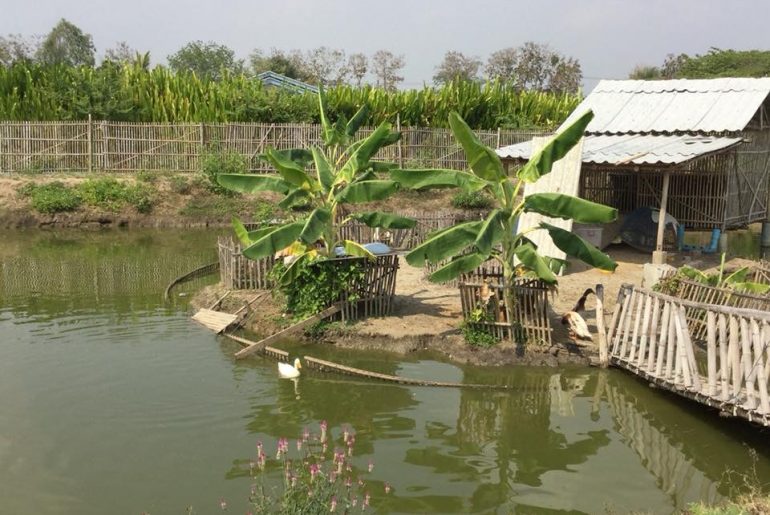
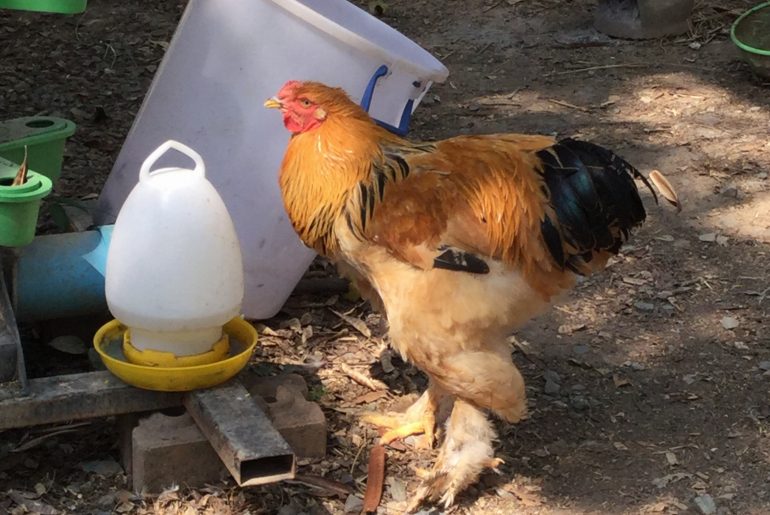

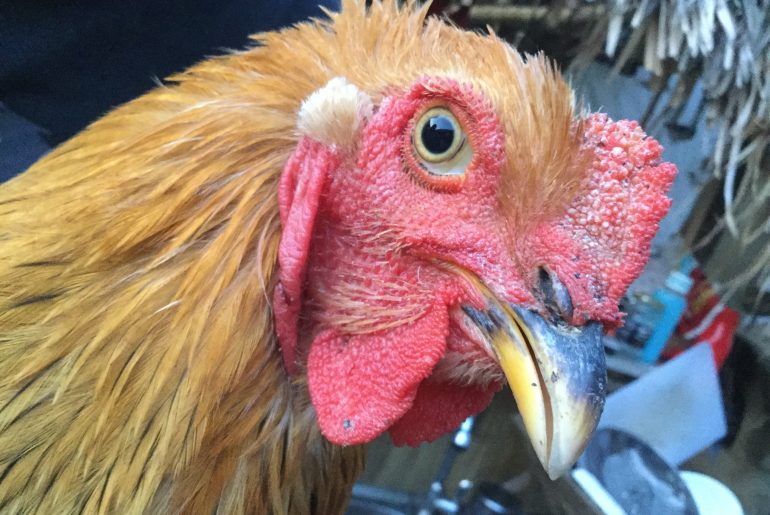
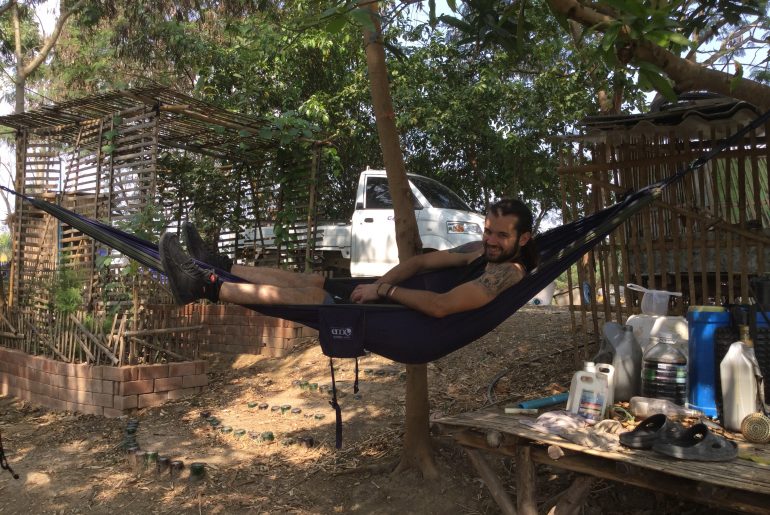
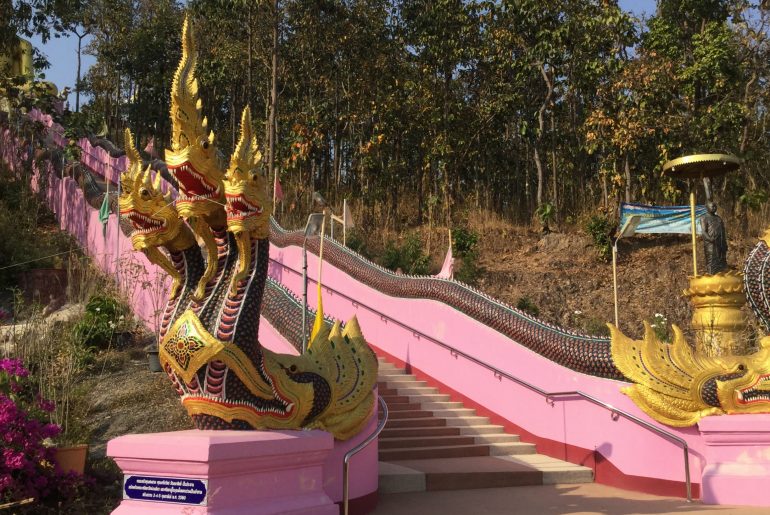
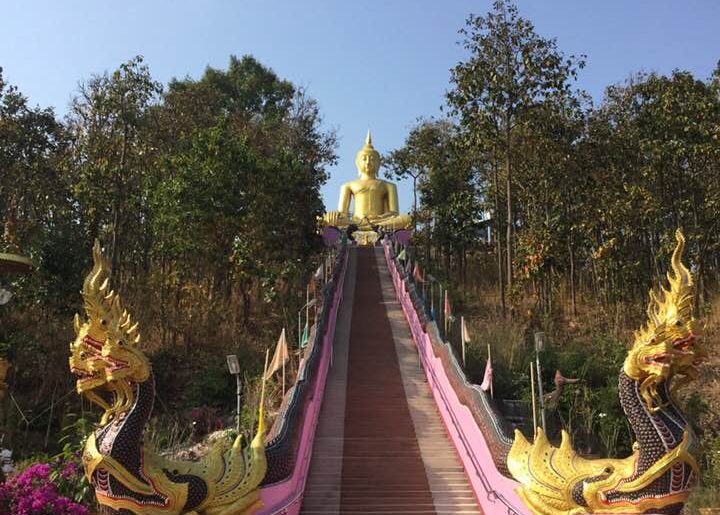
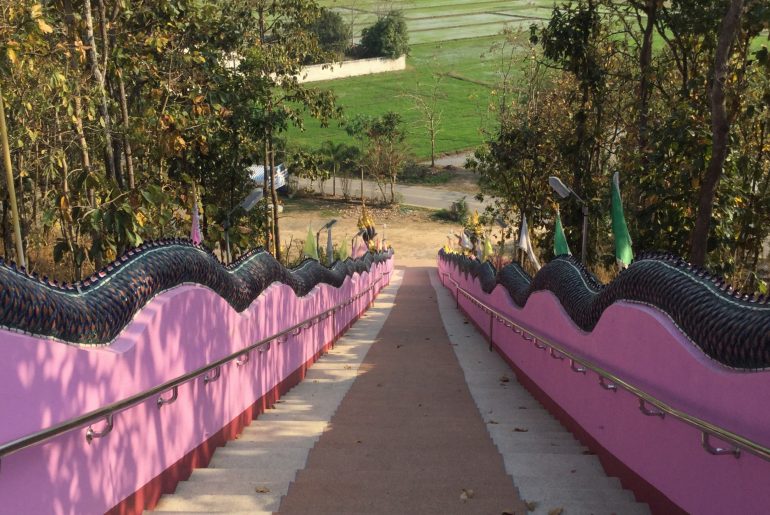
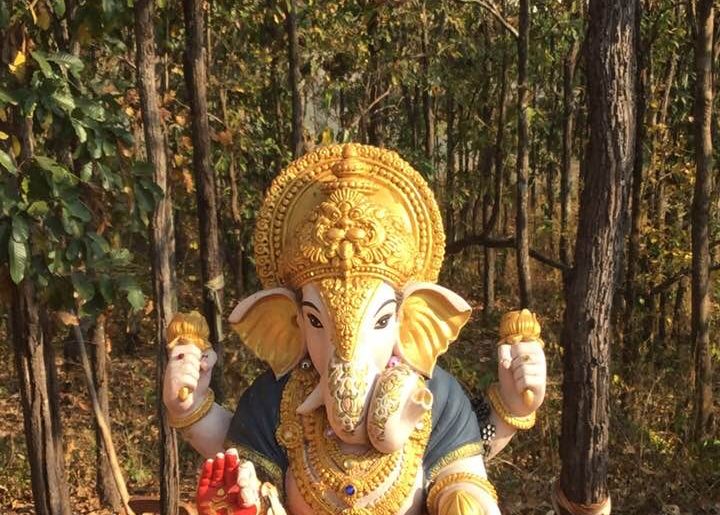
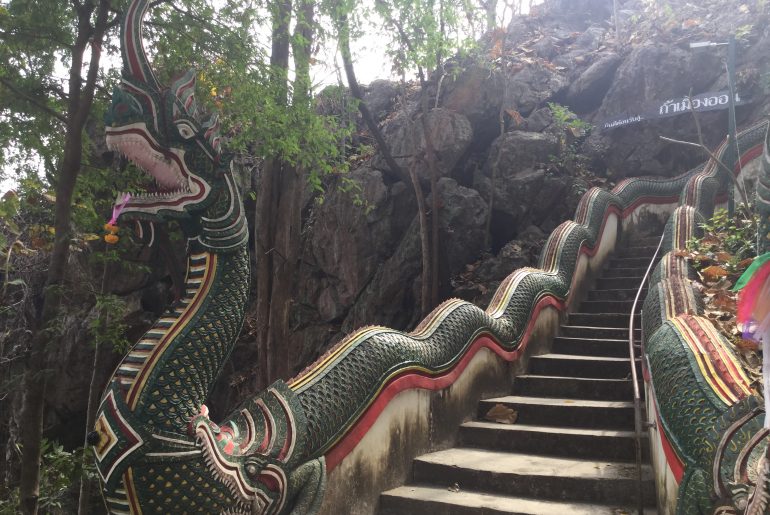
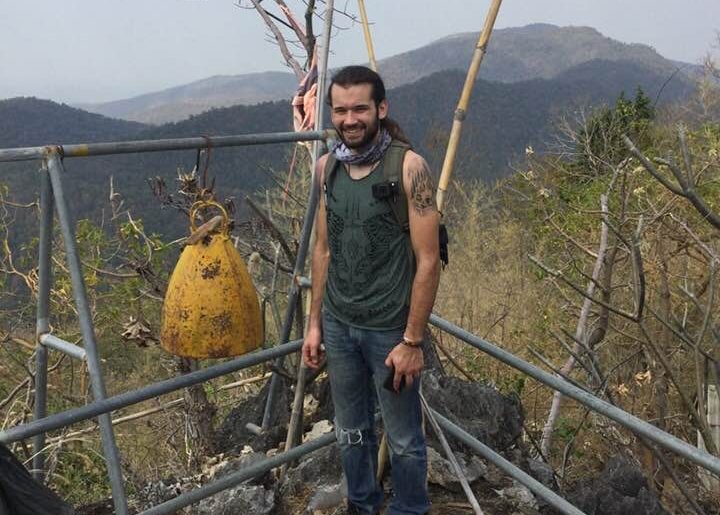
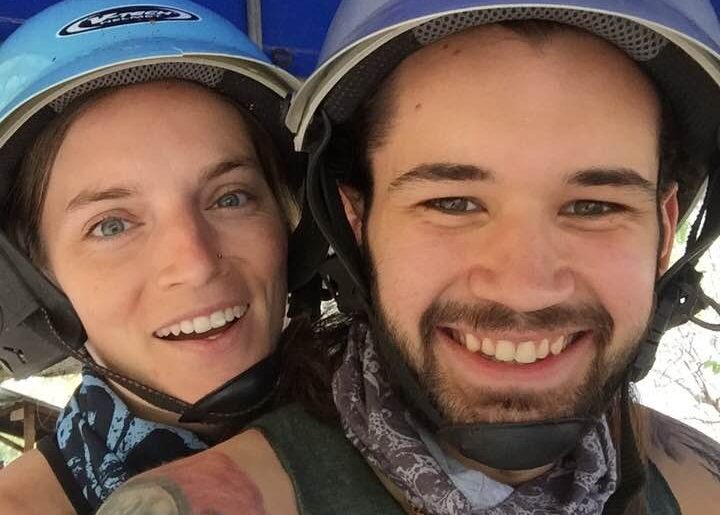

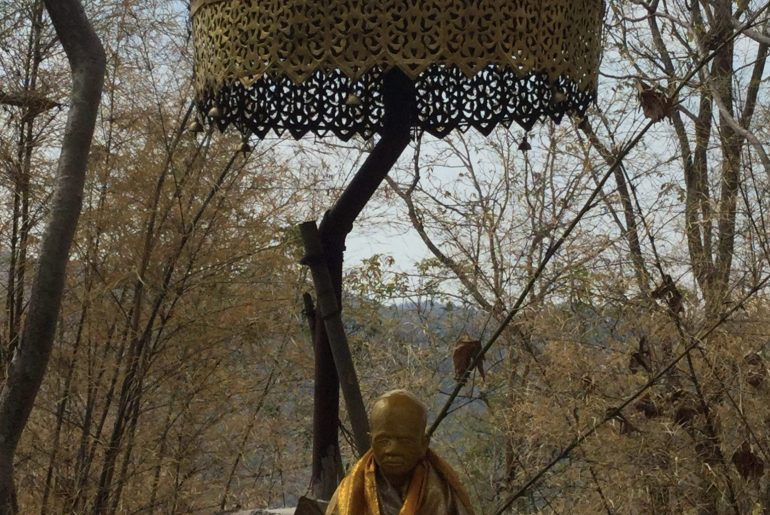
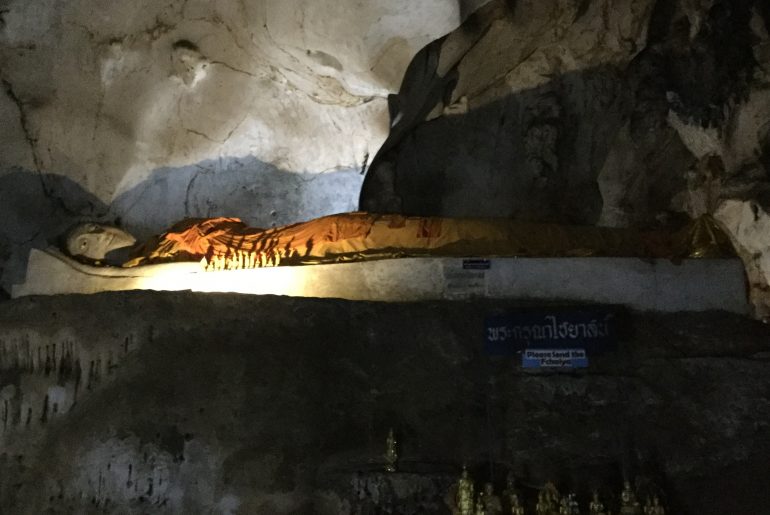
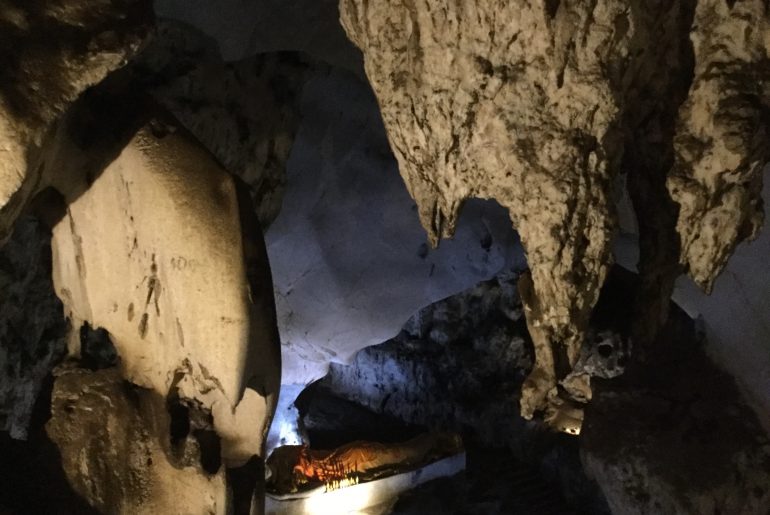
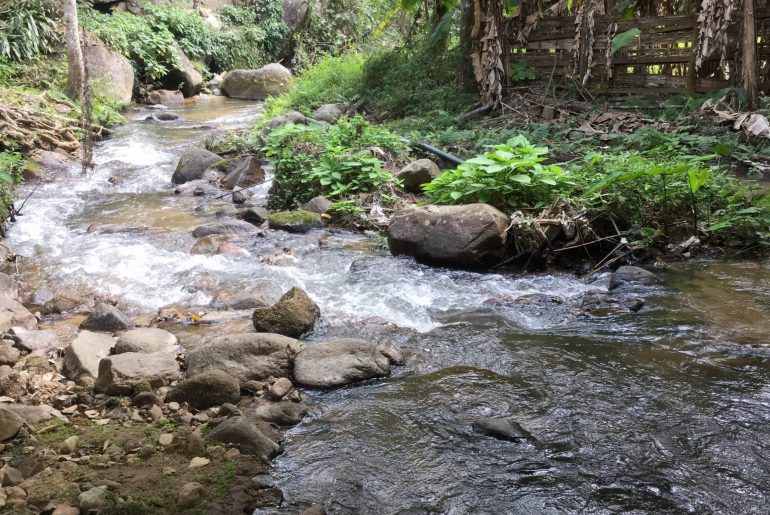
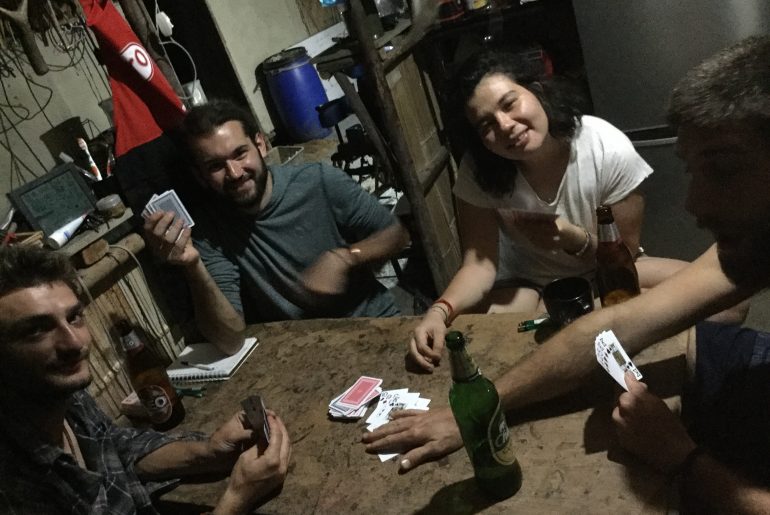

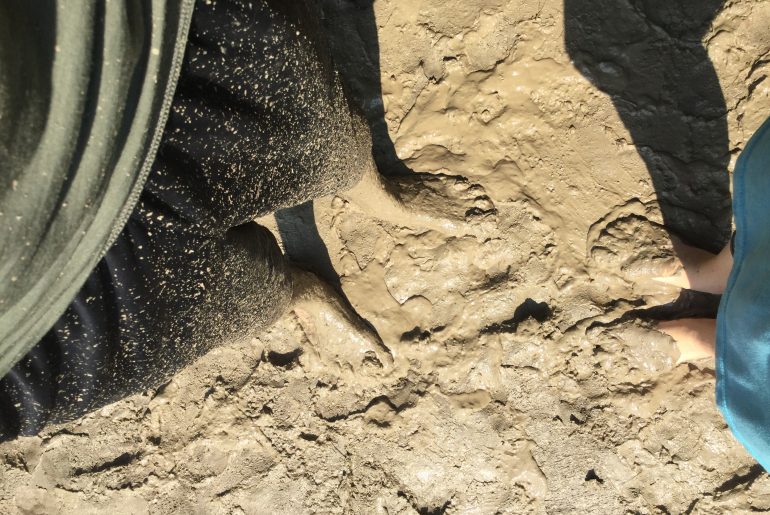
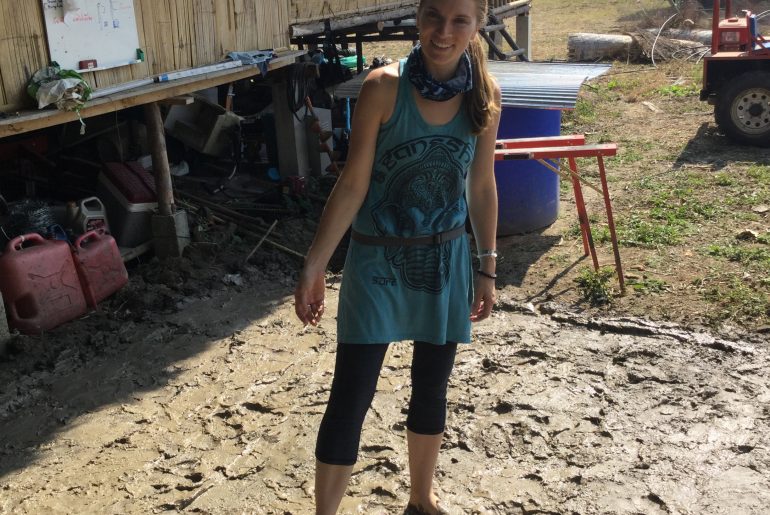
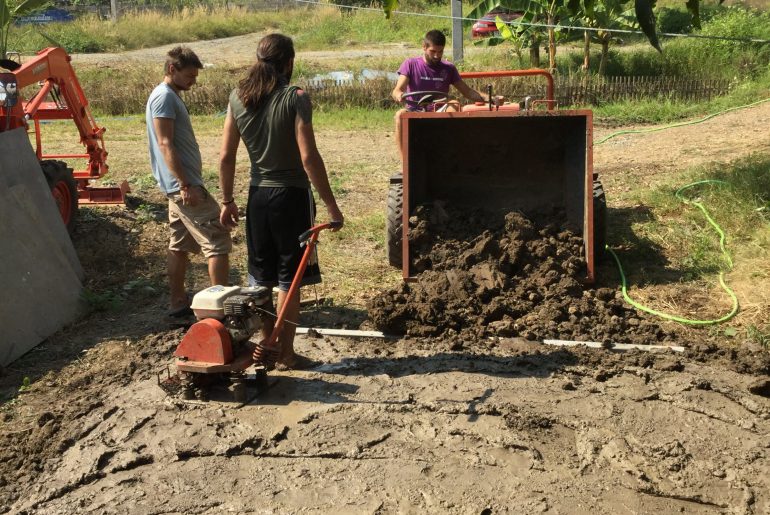
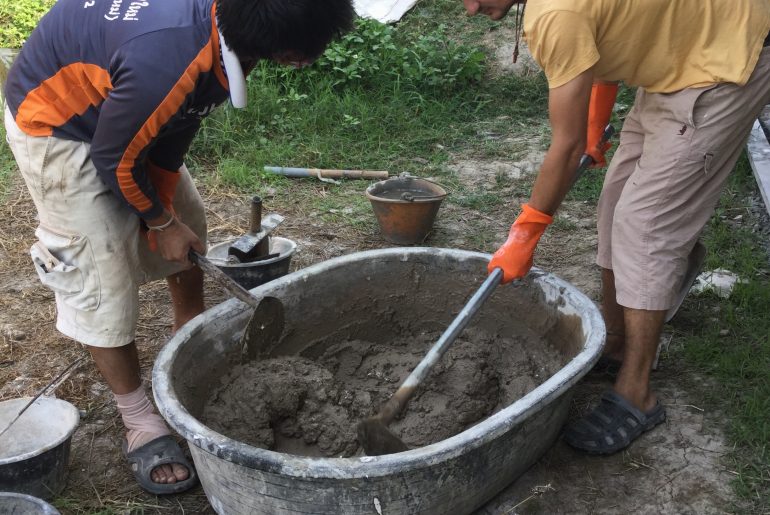
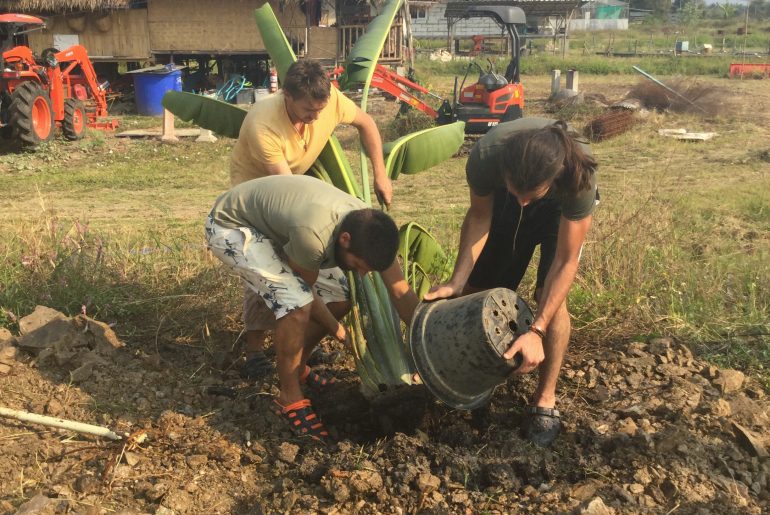
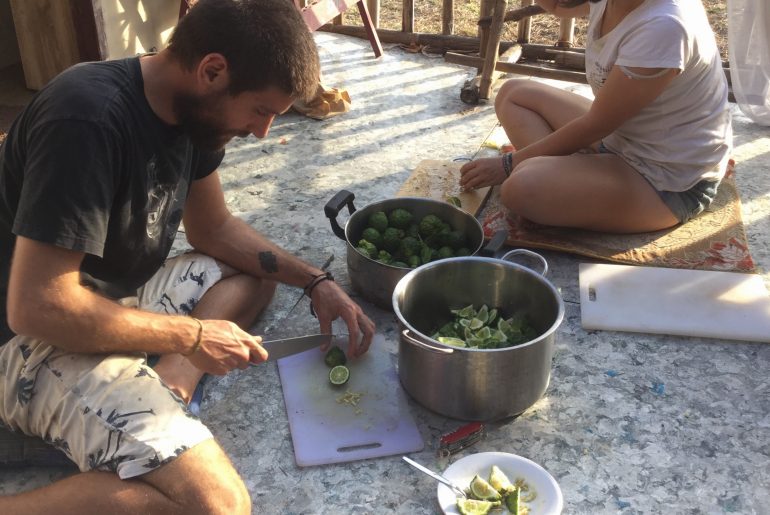
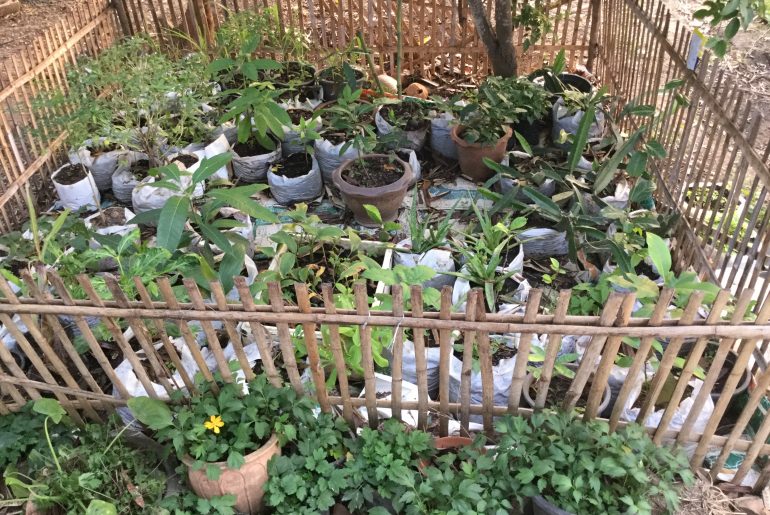
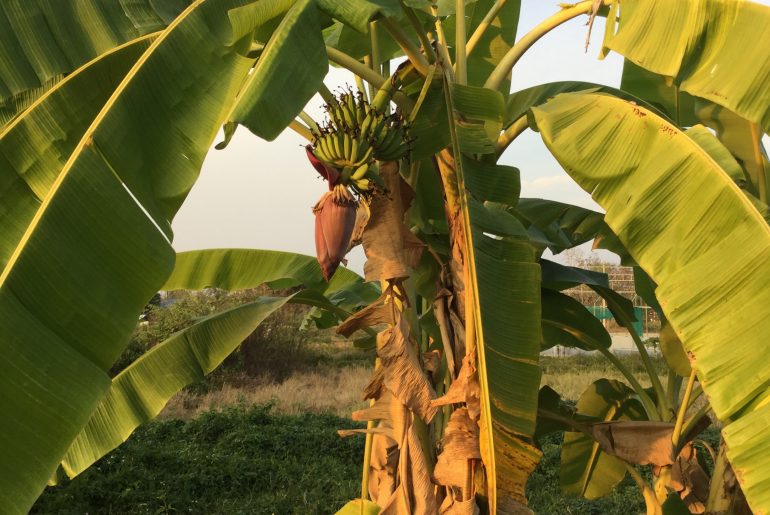
 After a few days of struggling to find a place to volunteer, we lined up an opportunity in San Kamphaeng about 20 minutes South East of Chiang Mai. It was a breath of fresh air getting out of the city. The director of the project, Xavier, stayed at a resort in a different location but on the land where we lived, there were 4 Thai people and 3 from France. Everyone was very welcoming, kind and funny! Accommodation and food were provided, in exchange, volunteered 4-5 hours a day and were able to take a day or two off to ourselves whenever we wanted. We stayed two weeks in a tent behind the bungalow. This was the longest I’ve spent in a tent and surprisingly I didn’t get sick of it until around the 10th day. Spending 2 weeks in a two-person tent feels a little tight after a while. We put up a wall to block some of the sun and eventually we added a roof to keep the sun out even more. At night the temperature dropped so it was nice sleeping weather. We often woke to a damp blanket but we adapted pretty quick. We usually woke up around 7:30 for breakfast and soon after began working, which was a good thing because around 9 AM it started getting hot around the tent. There were mornings where the goats would escape and we would hear them chomping on some plants right on the outside of our tent. I’ve grown very fond of goats, they are very verbal and have quite the personalities. Each day I began feeding them some of the leaves that were out of reach to them and every time I’d walk by them to get to our tent they would all look at me and baa. Someday I plan to have a little goat family, they are so cute!
After a few days of struggling to find a place to volunteer, we lined up an opportunity in San Kamphaeng about 20 minutes South East of Chiang Mai. It was a breath of fresh air getting out of the city. The director of the project, Xavier, stayed at a resort in a different location but on the land where we lived, there were 4 Thai people and 3 from France. Everyone was very welcoming, kind and funny! Accommodation and food were provided, in exchange, volunteered 4-5 hours a day and were able to take a day or two off to ourselves whenever we wanted. We stayed two weeks in a tent behind the bungalow. This was the longest I’ve spent in a tent and surprisingly I didn’t get sick of it until around the 10th day. Spending 2 weeks in a two-person tent feels a little tight after a while. We put up a wall to block some of the sun and eventually we added a roof to keep the sun out even more. At night the temperature dropped so it was nice sleeping weather. We often woke to a damp blanket but we adapted pretty quick. We usually woke up around 7:30 for breakfast and soon after began working, which was a good thing because around 9 AM it started getting hot around the tent. There were mornings where the goats would escape and we would hear them chomping on some plants right on the outside of our tent. I’ve grown very fond of goats, they are very verbal and have quite the personalities. Each day I began feeding them some of the leaves that were out of reach to them and every time I’d walk by them to get to our tent they would all look at me and baa. Someday I plan to have a little goat family, they are so cute!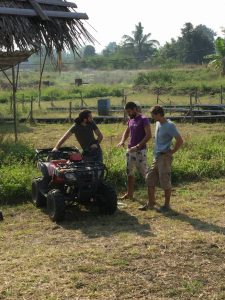 There was an assortment of work we did while we were volunteering. There are goats, pigeons, ducks and geese on the land so some of the work was making sure the animals were fed and also planting trees around the land. We helped with building the bungalow by laying bricks, hanging metal studs for drywall and putting up plaster. This was my first time ever doing plaster and it was a lot harder than it looks! Eventually, I got the hang of it and the wall was super smooth but it definitely takes practice to get quicker at it. The bungalow is being built for Xavier and his family to live in, along with a few others. We also helped with the creation of the terrace which was created with the intentions of having a larger eating area so everyone can eat together. This was a fun project, we got to walk in the cold, mushy clay with our bare feet. Jesse also spent a short time getting the 4 wheeler running again and another machine. He really is quite the handyman when it comes to fixing machines.
There was an assortment of work we did while we were volunteering. There are goats, pigeons, ducks and geese on the land so some of the work was making sure the animals were fed and also planting trees around the land. We helped with building the bungalow by laying bricks, hanging metal studs for drywall and putting up plaster. This was my first time ever doing plaster and it was a lot harder than it looks! Eventually, I got the hang of it and the wall was super smooth but it definitely takes practice to get quicker at it. The bungalow is being built for Xavier and his family to live in, along with a few others. We also helped with the creation of the terrace which was created with the intentions of having a larger eating area so everyone can eat together. This was a fun project, we got to walk in the cold, mushy clay with our bare feet. Jesse also spent a short time getting the 4 wheeler running again and another machine. He really is quite the handyman when it comes to fixing machines.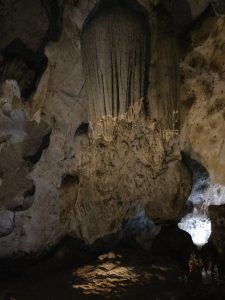 On the land, we had access to a bicycle and a tandem bicycle to go to the local market. Every few days we would go to the market to get fresh veggies and tofu. We took turns preparing food, most times we ate together and generally if you were to cook, you cook enough food for everyone. There was a small outdoor kitchen, very cute but a little crowded when multiple people were in there trying to cook. Over time when the bungalow is finished, the kitchen will expand. There was also access to a motorbike so we used that instead of the bicycles. We would often take it for a ride to the store to grab a snack or drink. On one of our days off, we took a ride up into the mountains to a local cave. The motorbike struggled a little to get up the hill and at one point we had to shut it off and give it a rest, but we made it. The cave was pretty sweet, the ceilings were tall and on a few rocks, I saw a crystal-like substance shimmering. Throughout the cave, there were Buddha temples and we saw quite a few people stopping to meditate and show their respect. Unfortunately, the camera we have isn’t the best so we didn’t get any good shots of the cave. After we stepped outside, we hiked up the rest of the mountain. It was nice to be at the top feeling the fresh breeze and we saw a few monkeys hanging out in the trees.
On the land, we had access to a bicycle and a tandem bicycle to go to the local market. Every few days we would go to the market to get fresh veggies and tofu. We took turns preparing food, most times we ate together and generally if you were to cook, you cook enough food for everyone. There was a small outdoor kitchen, very cute but a little crowded when multiple people were in there trying to cook. Over time when the bungalow is finished, the kitchen will expand. There was also access to a motorbike so we used that instead of the bicycles. We would often take it for a ride to the store to grab a snack or drink. On one of our days off, we took a ride up into the mountains to a local cave. The motorbike struggled a little to get up the hill and at one point we had to shut it off and give it a rest, but we made it. The cave was pretty sweet, the ceilings were tall and on a few rocks, I saw a crystal-like substance shimmering. Throughout the cave, there were Buddha temples and we saw quite a few people stopping to meditate and show their respect. Unfortunately, the camera we have isn’t the best so we didn’t get any good shots of the cave. After we stepped outside, we hiked up the rest of the mountain. It was nice to be at the top feeling the fresh breeze and we saw a few monkeys hanging out in the trees.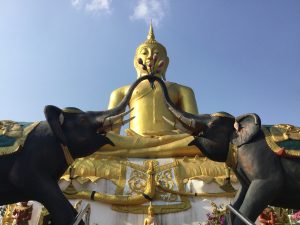
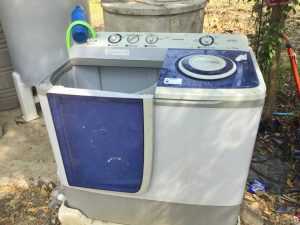 This was a really great experience because we were truly living on the land and helping with the everyday daily tasks. The washing machine was solar powered too and it had a dryer attached to it. It wasn’t a typical dryer though, this one somehow heated the clothes while they spun and after about 10 minutes spinning you open the lid and the clothes are generally pretty dry. A little damp but nowhere near as wet as when you put them in the dryer. It was a very cool process and the fact that it was solar powered was really amazing. Being out in the country we were able to experience a little more about Thai culture. At night 2 of the Thai guys would go hunting with their handmade air rifle and a headlamp. They are excellent hunters and often came back with random birds, rats, and frogs, which they would eat the next day. Many Thai people are very genuine and kind and are always willing to lend a hand where it is needed.
This was a really great experience because we were truly living on the land and helping with the everyday daily tasks. The washing machine was solar powered too and it had a dryer attached to it. It wasn’t a typical dryer though, this one somehow heated the clothes while they spun and after about 10 minutes spinning you open the lid and the clothes are generally pretty dry. A little damp but nowhere near as wet as when you put them in the dryer. It was a very cool process and the fact that it was solar powered was really amazing. Being out in the country we were able to experience a little more about Thai culture. At night 2 of the Thai guys would go hunting with their handmade air rifle and a headlamp. They are excellent hunters and often came back with random birds, rats, and frogs, which they would eat the next day. Many Thai people are very genuine and kind and are always willing to lend a hand where it is needed.

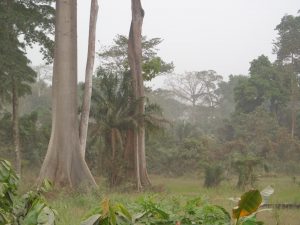 On my trip to Ghana, I was accompanied by Cha Cha and Ashley. Ashley and I soon became friends, wandered the land together and walked for what seemed like forever in the blazing sun. We shared a room together with bright pink painted walls and a small electric fan. There were times at night where the electricity would shut off for an unknown amount time and we would wake up sweating, to step outside and see the rest of the family laying out under the stars. One night I pulled my mattress out there too, unfortunately, I forgot to put on bug spray and woke to around 30 bug bites at my ankles. Bugs are really sneaky, you often don’t even feel them on you, yet you have bites all over. I’m grateful to have shared this experience with another woman, something I will forever cherish.
On my trip to Ghana, I was accompanied by Cha Cha and Ashley. Ashley and I soon became friends, wandered the land together and walked for what seemed like forever in the blazing sun. We shared a room together with bright pink painted walls and a small electric fan. There were times at night where the electricity would shut off for an unknown amount time and we would wake up sweating, to step outside and see the rest of the family laying out under the stars. One night I pulled my mattress out there too, unfortunately, I forgot to put on bug spray and woke to around 30 bug bites at my ankles. Bugs are really sneaky, you often don’t even feel them on you, yet you have bites all over. I’m grateful to have shared this experience with another woman, something I will forever cherish.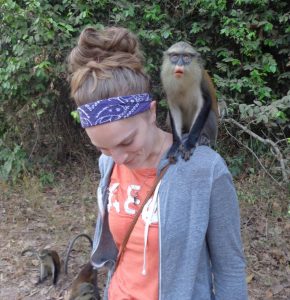 While we were there we mainly worked on digging up clay, which would be used to mold bricks for the guest house building. We visited the village of Aklorbortornu where we donated some school supplies to a group of children who have limited opportunity for education and no school building. One of Ndor’s projects is to build those children a school. In our free time, we were able to go on adventures through town, see the monkey sanctuary, Wili Waterfall, and observe at a local school. Being a teacher I always look forward to seeing how schools in other countries are run. You can read more about my school observations in the Ghana education post.
While we were there we mainly worked on digging up clay, which would be used to mold bricks for the guest house building. We visited the village of Aklorbortornu where we donated some school supplies to a group of children who have limited opportunity for education and no school building. One of Ndor’s projects is to build those children a school. In our free time, we were able to go on adventures through town, see the monkey sanctuary, Wili Waterfall, and observe at a local school. Being a teacher I always look forward to seeing how schools in other countries are run. You can read more about my school observations in the Ghana education post.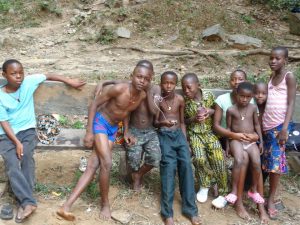 On a different day we gathered up a group of the local kids and kids in the family and went to the Wli waterfall, the tallest waterfall in Ghana. Many of the children rarely leave their towns and villages so this was a special time for them. It’s respectful as a foreigner not to show too much of your body, so we wore leggings and tank tops and walked into the water. I remember being pulled to go closer and closer and at one point I was directly under the waterfall. It beat down on me so hard that I lost my breath and had to step out. The majority of the children can’t swim because they don’t have the opportunity to practice so they stayed at the edge, just splashing around in a foot or two of water. At one point we looked at the waterfall and this beautiful rainbow appeared, spreading across the waterfall. You can see a picture of it on the first blog post. The song natural mystic came to mind, it was a magical moment. Being in Africa and seeing certain situations, many Bob Marley and the Wailers lyrics began to have a whole new depth and meaning for me. At times it was as if I was seeing the visual representation of the lyrics and as I sang in my head it brought a smile to my face. You can hear a lyric and enjoy the words, but just like the Grateful Dead, sometimes you have a moment in time where you’re like whoa I actually understand because I’m experiencing it. When I saw people sleeping on the cold ground and wearing shoes too small for their feet, the song “Talking Blues“ became a powerful one for me.
On a different day we gathered up a group of the local kids and kids in the family and went to the Wli waterfall, the tallest waterfall in Ghana. Many of the children rarely leave their towns and villages so this was a special time for them. It’s respectful as a foreigner not to show too much of your body, so we wore leggings and tank tops and walked into the water. I remember being pulled to go closer and closer and at one point I was directly under the waterfall. It beat down on me so hard that I lost my breath and had to step out. The majority of the children can’t swim because they don’t have the opportunity to practice so they stayed at the edge, just splashing around in a foot or two of water. At one point we looked at the waterfall and this beautiful rainbow appeared, spreading across the waterfall. You can see a picture of it on the first blog post. The song natural mystic came to mind, it was a magical moment. Being in Africa and seeing certain situations, many Bob Marley and the Wailers lyrics began to have a whole new depth and meaning for me. At times it was as if I was seeing the visual representation of the lyrics and as I sang in my head it brought a smile to my face. You can hear a lyric and enjoy the words, but just like the Grateful Dead, sometimes you have a moment in time where you’re like whoa I actually understand because I’m experiencing it. When I saw people sleeping on the cold ground and wearing shoes too small for their feet, the song “Talking Blues“ became a powerful one for me.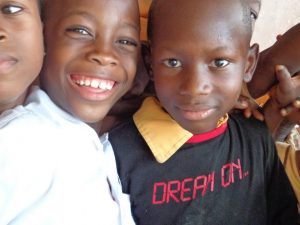 When you hear about Africa on the news, in general, its portrayed as very poor with violence and hungry people. The commercials, movies, and images that are shown put fear into peoples minds about traveling to an African country. I recall people getting worried telling me that I’ll get sick, get malaria, or possibly even die there. Besides your occasional homeless person on the street, from what I saw of Ghana everyone seemed to eat enough. Yes, there are countries in Africa where people are hungry and malnourished but I think we need to stop giving the entire continent of Africa that image.
When you hear about Africa on the news, in general, its portrayed as very poor with violence and hungry people. The commercials, movies, and images that are shown put fear into peoples minds about traveling to an African country. I recall people getting worried telling me that I’ll get sick, get malaria, or possibly even die there. Besides your occasional homeless person on the street, from what I saw of Ghana everyone seemed to eat enough. Yes, there are countries in Africa where people are hungry and malnourished but I think we need to stop giving the entire continent of Africa that image.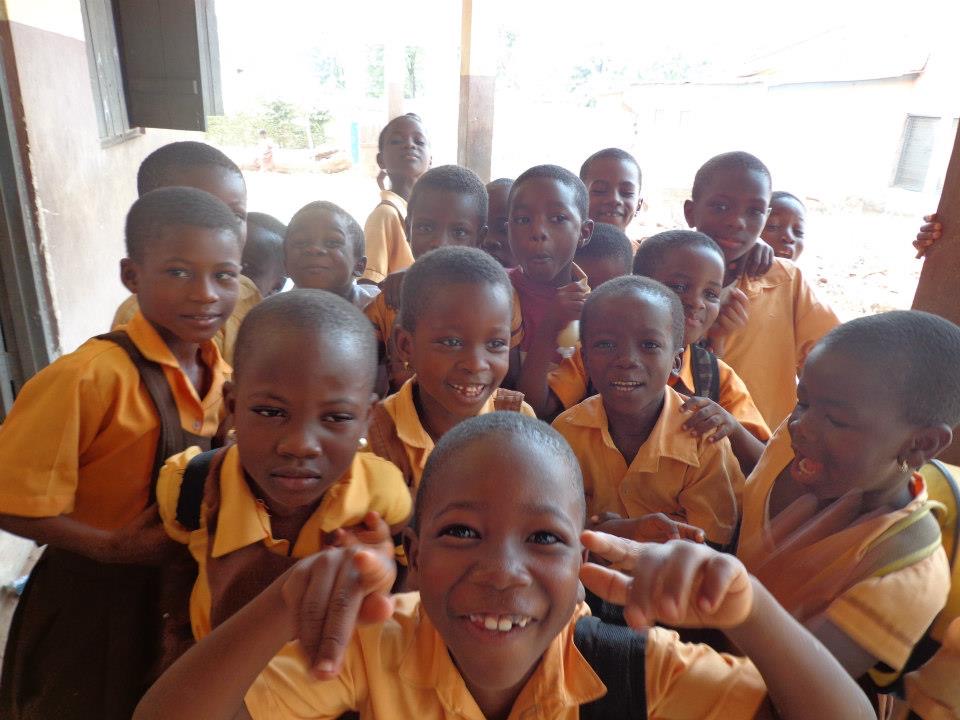 My favorite part of Ghana was meeting all of the children, which seems to be my favorite part of every country. They are eager to learn and are very funny! I will never forget all those smiling faces or their reactions when we walked into their schoolyard. In a matter of seconds, you have about 20 children crowding around you. There were moments where I had children touching my skin, just to touch it, or multiple little hands wanting me to hold theirs. They often tried to scratch my freckles off because they’ve never seen them before or touch my hair because blonde was new to them. The children were very hands-on and always willing to shower you with infinite amounts of love.
My favorite part of Ghana was meeting all of the children, which seems to be my favorite part of every country. They are eager to learn and are very funny! I will never forget all those smiling faces or their reactions when we walked into their schoolyard. In a matter of seconds, you have about 20 children crowding around you. There were moments where I had children touching my skin, just to touch it, or multiple little hands wanting me to hold theirs. They often tried to scratch my freckles off because they’ve never seen them before or touch my hair because blonde was new to them. The children were very hands-on and always willing to shower you with infinite amounts of love.